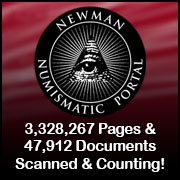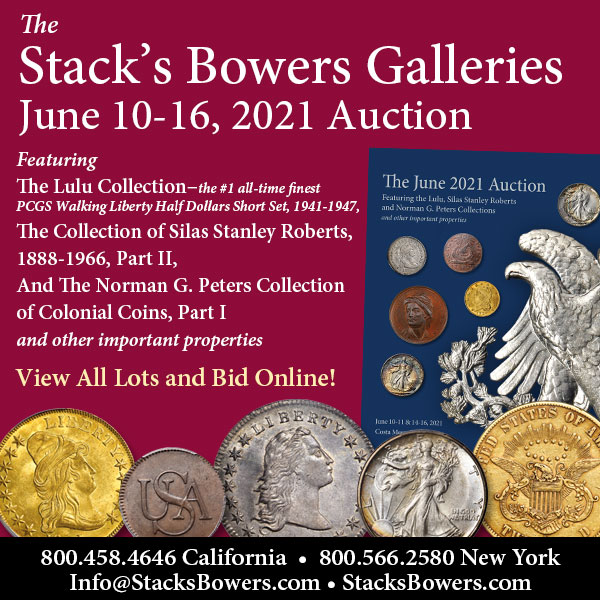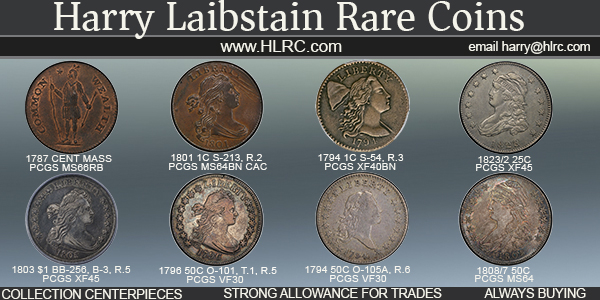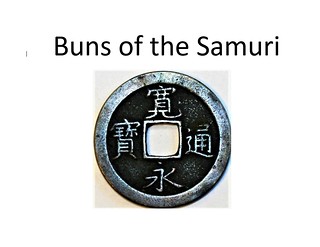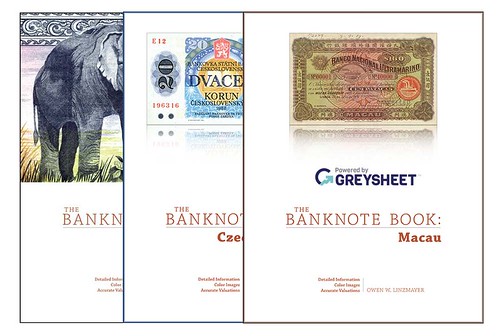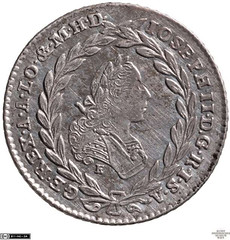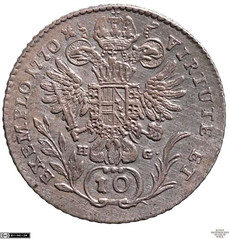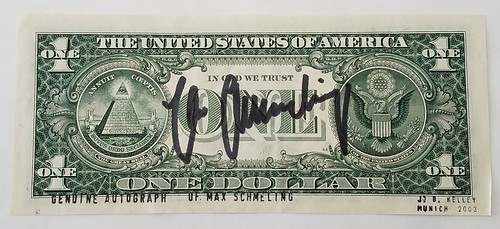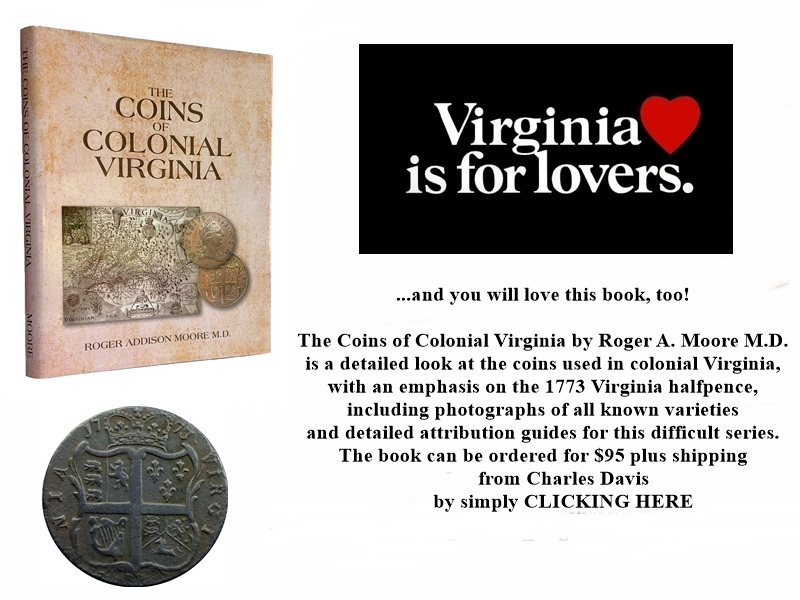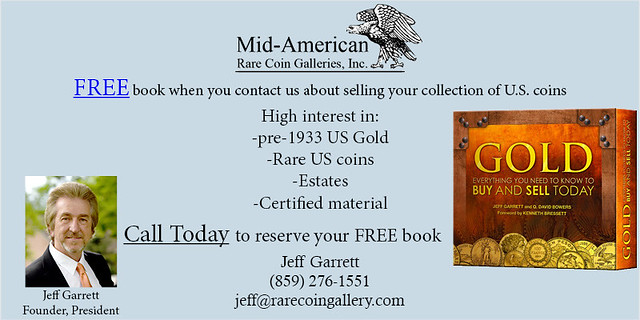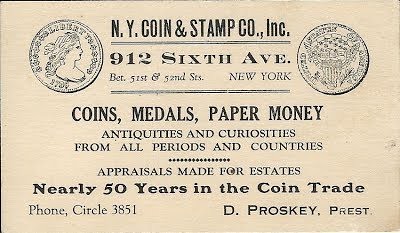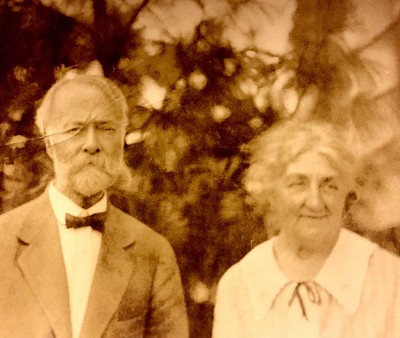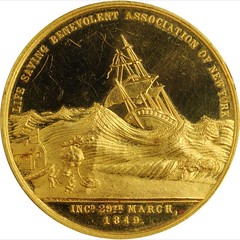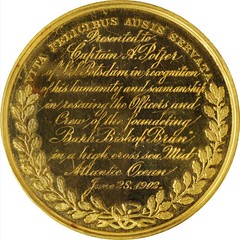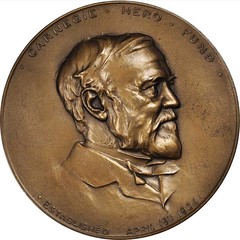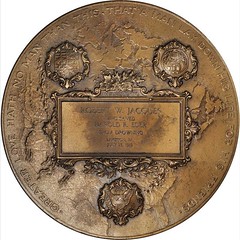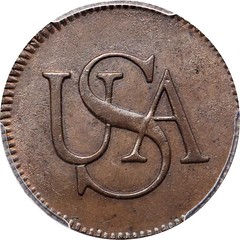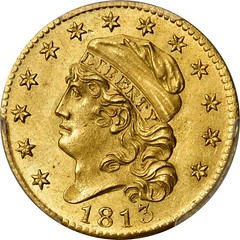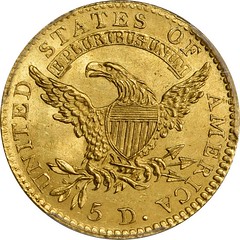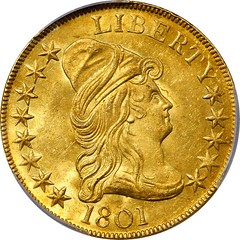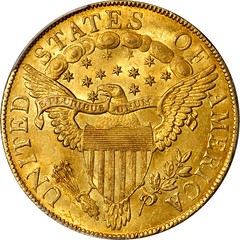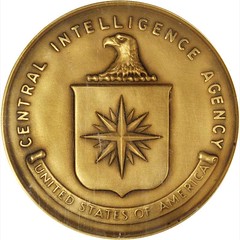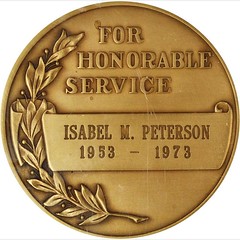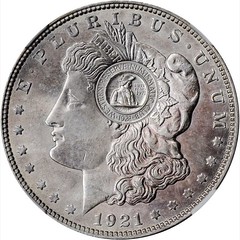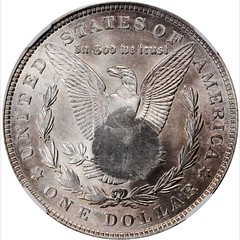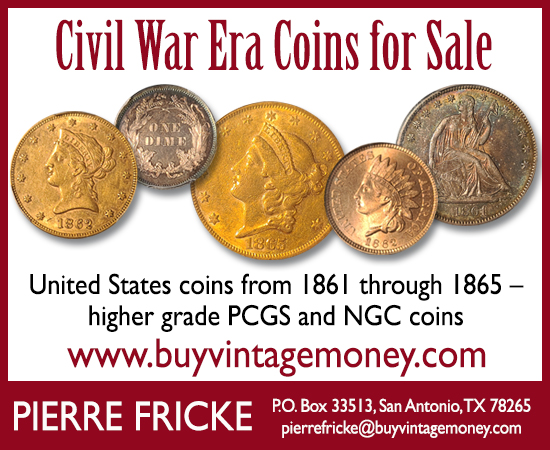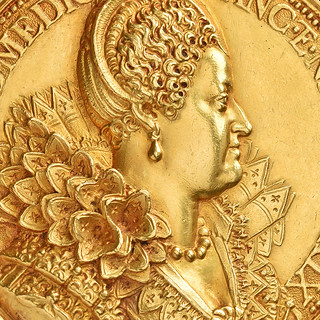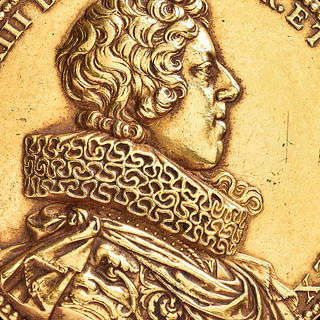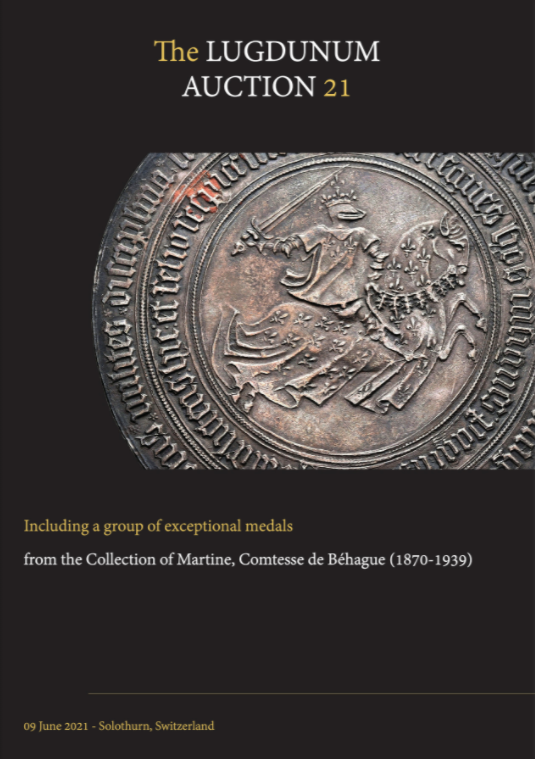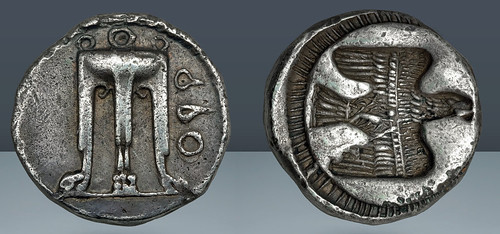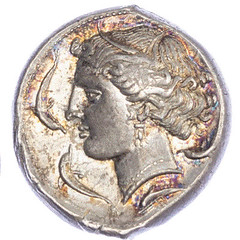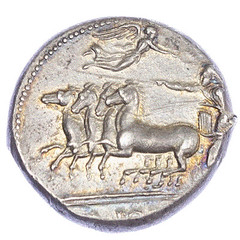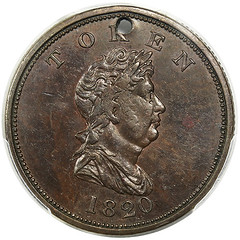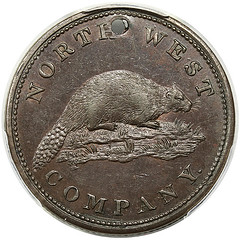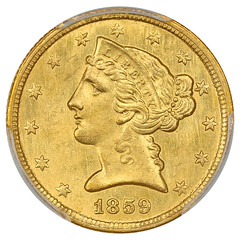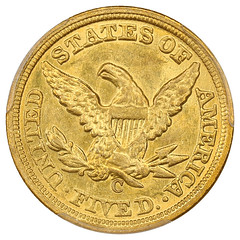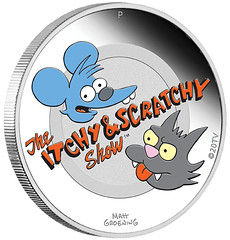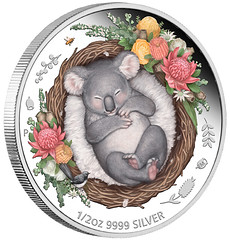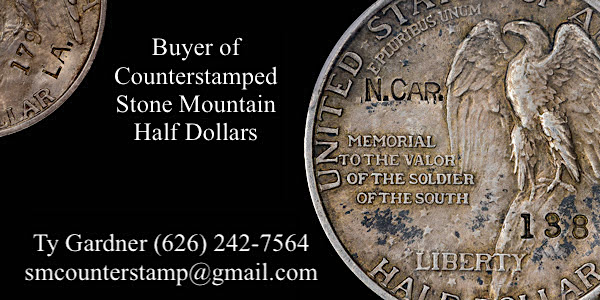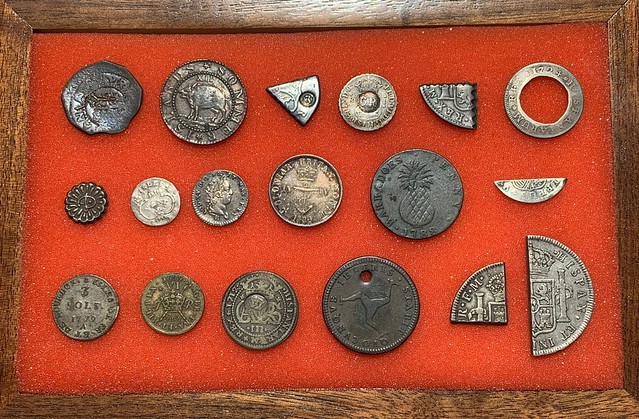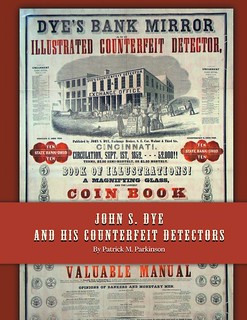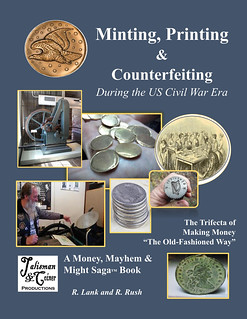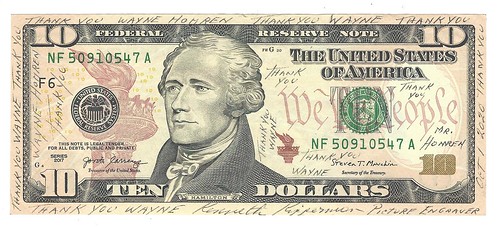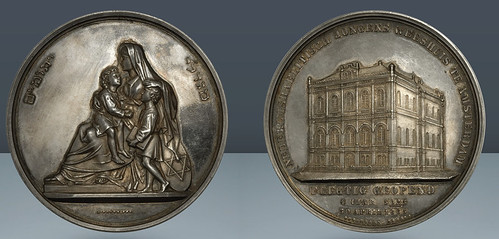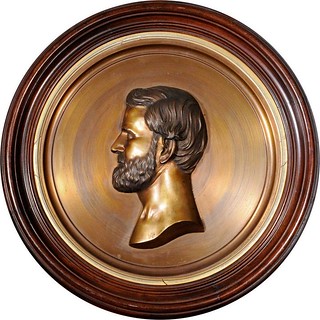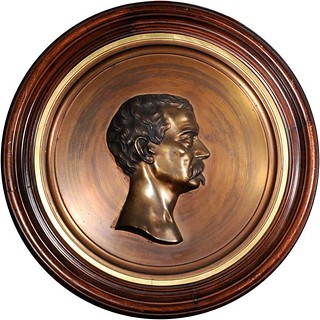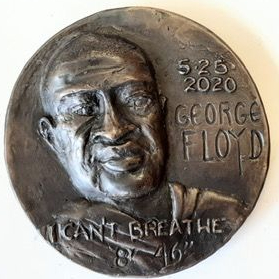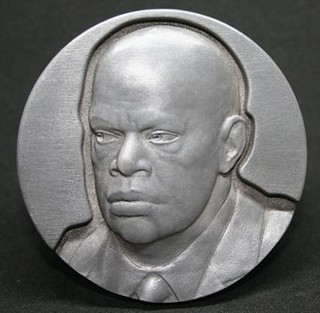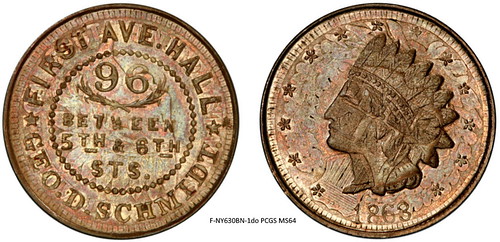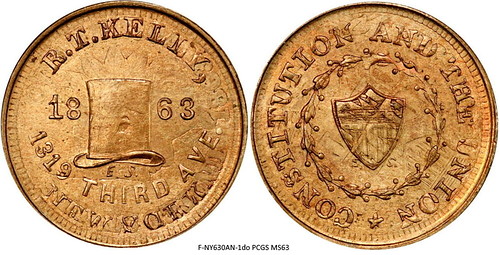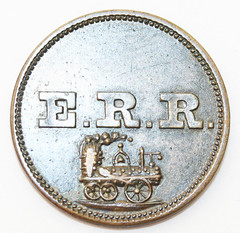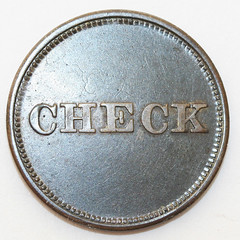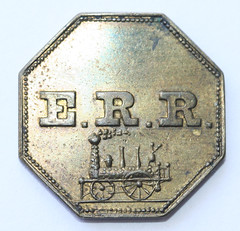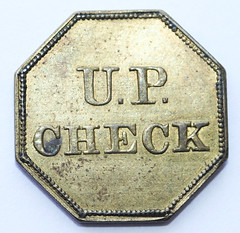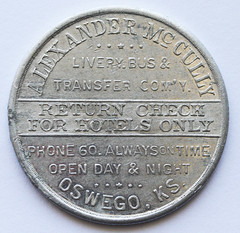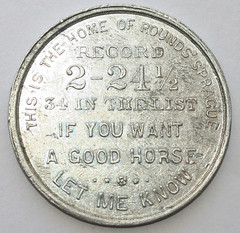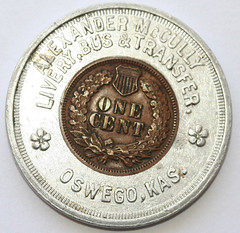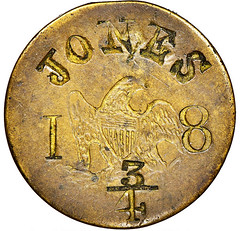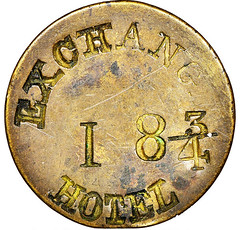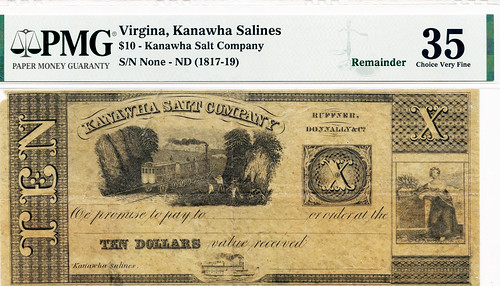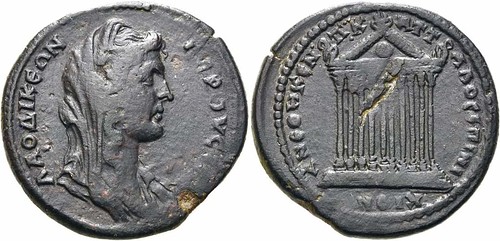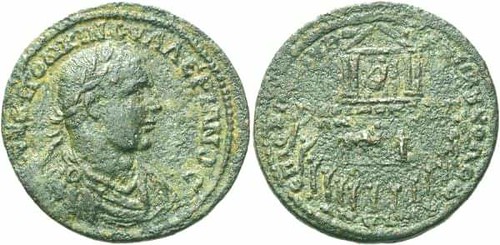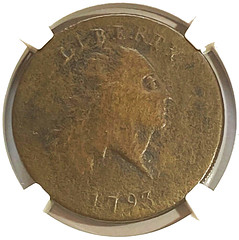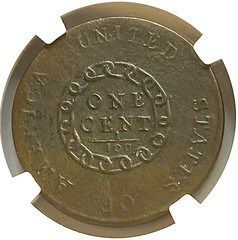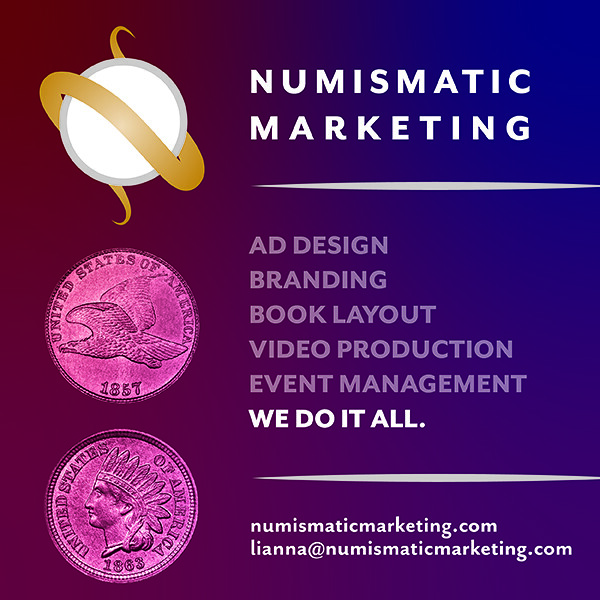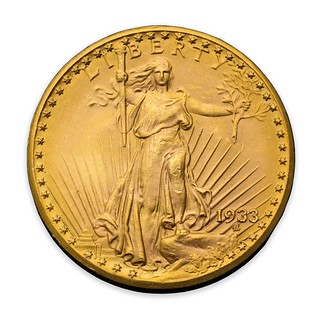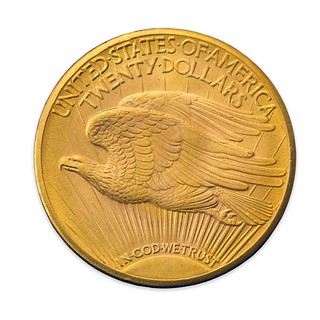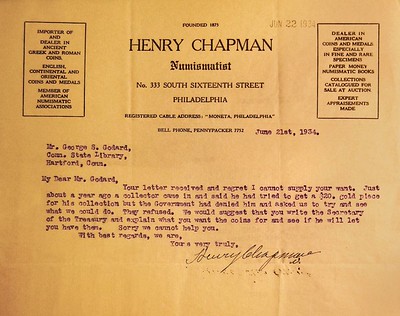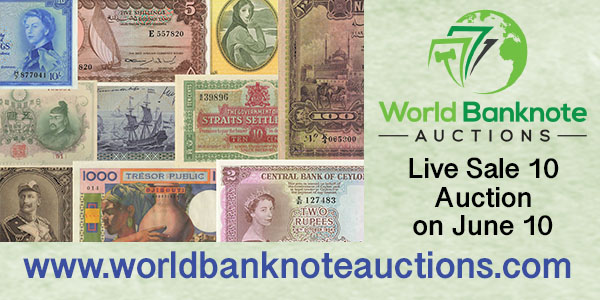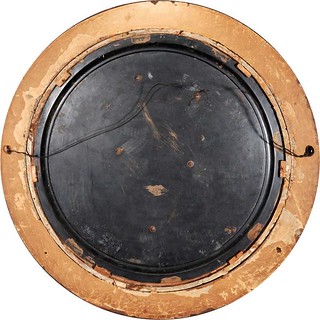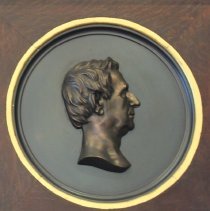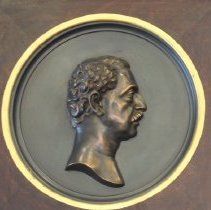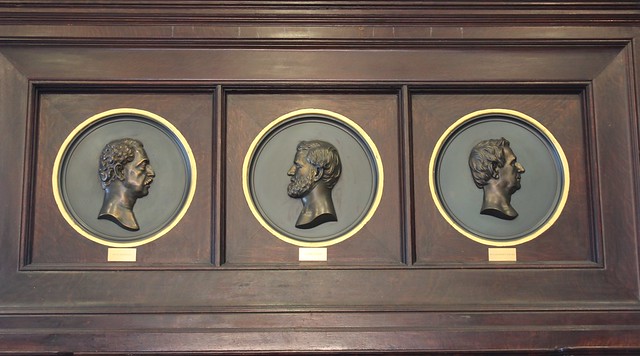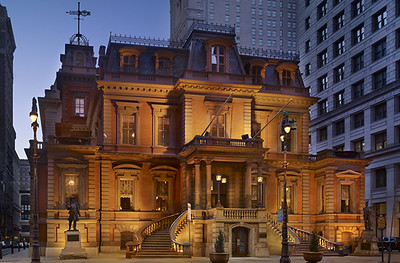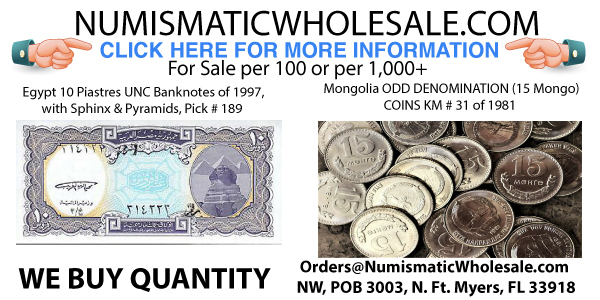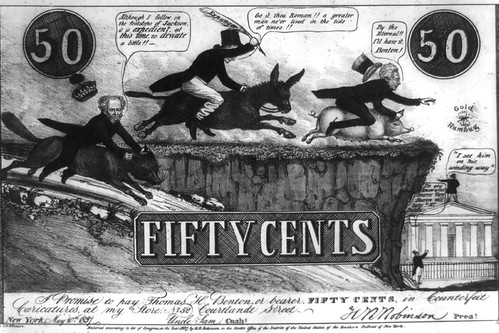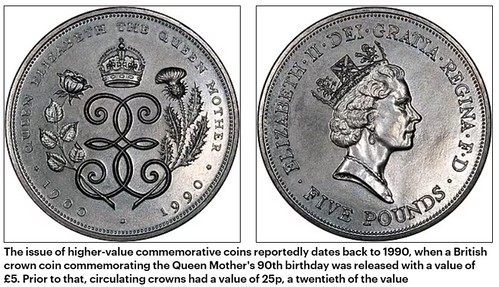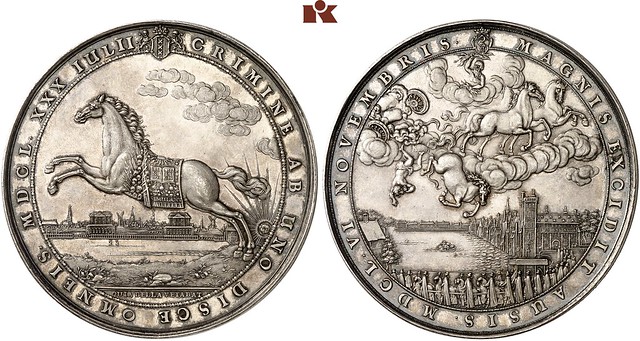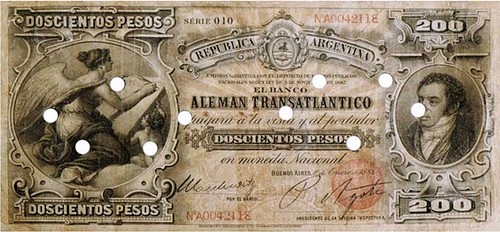
Visit our NBS Sponsors


About UsThe Numismatic Bibliomania Society is a non-profit association devoted to the study and enjoyment of numismatic literature. For more information please see our web site at coinbooks.org SubscriptionsThose wishing to become new E-Sylum subscribers (or wishing to Unsubscribe) can go to the following web page link MembershipThere is a membership application available on the web site Membership Application To join, print the application and return it with your check to the address printed on the application. Print/Digital membership is $40 to addresses in the U.S., and $60 elsewhere. A digital-only membership is available for $25. For those without web access, write to: Charles Heck, Treasurer AsylumFor Asylum mailing address changes and other membership questions, contact Chuck at this email address: treasurer@coinbooks.org SubmissionsTo submit items for publication in The E-Sylum, write to the Editor at this address: whomren@gmail.com BUY THE BOOK BEFORE THE COINSale Calendar
|
- WAYNE'S WORDS: THE E-SYLUM MAY 30, 2021
- NEW BOOK: 2021 VARIETIES OF U.S. LARGE CENTS
- NEW MONOGRAPH: BUNS OF THE SAMURI
- CDN PUBLISHING ACQUIRES THE BANKNOTE BOOK
- NUMISMATIC BOOK PUBLISHING IN 2020
- DANIEL ALLEN FREELAND (1949-2021)
- NNP LAUNCHES NUMISMATIC NOTABLES
- VIDEO: A THOUSAND OUNCE BAR OF SILVER
- NOTES FROM E-SYLUM READERS: MAY 30, 2021
- DOLLAR BILLS AS MESSENGERS
- VOCABULARY TERM: EDGE LETTERING, PART 3
- MORE ON DAVID ULYSSES PROSKEY (1853-1928)
- STACKS BOWERS JUNE 2021 SALE SELECTIONS
- LUGDUNUM AUCTION 21 HIGHLIGHTS
- NUMISMATIC NUGGETS: MAY 30, 2021
- ANCIENT AMULET: SOLOMON'S SEAL
- WAYNE'S NUMISMATIC DIARY MAY 30, 2021
- A MEMORABLE CHAIN CENT PURCHASE
- THE U.S. MINT AND THE MANHATTAN PROJECT
- THE FAROUK 1933 DOUBLE EAGLE, PART 2
- THE AUCTION OF A PURPLE HEART
- THE NATIONAL BRONZE PICTURE GALLERY
- THE CASHIER WHO TOOK GEORGE FLOYD'S $20 BILL
- WALL STREET'S CRYPTO ARTIST
- STABLECOINS AND THE WILD WEST OF FINANCE
- CAN I PAY THE TAXMAN IN COMMEMORATIVE COINS?
- CIRCULATING AND NON-CIRCULATING LEGAL TENDER
- LOOSE CHANGE: MAY 30, 2021
Click here to read the thin version on the web
Click here to subscribe
Click here to access the complete archive
To comment or submit articles, reply to whomren@gmail.com
Content presented in The E-Sylum is not necessarily researched or independently fact-checked, and views expressed do not necessarily represent those of the Numismatic Bibliomania Society.
WAYNE'S WORDS: THE E-SYLUM MAY 30, 2021
 New subscribers this week include: Norm Cochrane, Bob Grellman, and Allen Ross. Welcome aboard! We now have 6,636 subscribers.
New subscribers this week include: Norm Cochrane, Bob Grellman, and Allen Ross. Welcome aboard! We now have 6,636 subscribers.
Thank you for reading The E-Sylum. If you enjoy it, please send me the email addresses of friends you think may enjoy it as well and I'll send them a subscription. Contact me at whomren@gmail.com anytime regarding your subscription, or questions, comments or suggestions about our content.
This week we open with two new books, the acquisition of The Banknote Book, numismatic publishing in 2020, updates from the Newman Numismatic Portal, and more.
Other topics this week include edge lettering, auction highlights, Solomon's Seal, a chain cent, the 1933 double eagle, the auction of a Purple Heart, the National Bronze Picture Gallery, the cashier who took George Floyd's $20 bill, Wall Street's crypto artist, the Wild West of finance, and paying the taxman in commemorative coins.
To learn more about Dan Freeland, John Adams, Max Schmeling, David Proskey, the thousand ounce bar of silver, testoons, Coin University, Bar Coppers, the CIA Honorable Service Medal, Martine, Comtesse de Béhague, Matthew Stickney's North West Co. token, buns of the Samuri, Bitchcoin, the modern version of mobile chests of silver, and Edward Rausch's Numismatic Urn, read on. Have a great week, everyone!
Wayne Homren
Editor, The E-Sylum
NEW BOOK: 2021 VARIETIES OF U.S. LARGE CENTS
A new edition of Bob Grellman's book on late date Large Cent die varieties has been published. Here's the announcement. -Editor
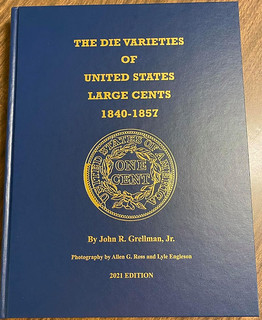 A new 2021 edition of The Die Varieties of United States Large Cents 1840-1857 by John R. (Bob) Grellman, Jr., is available for immediate delivery. The new book updates the 2000 edition that sold out many years ago. Hardbound, 451 pages with color photos of rarities and special die states, updated rarity and census information, and dozens of newly discovered rare die states are described in detail.
A new 2021 edition of The Die Varieties of United States Large Cents 1840-1857 by John R. (Bob) Grellman, Jr., is available for immediate delivery. The new book updates the 2000 edition that sold out many years ago. Hardbound, 451 pages with color photos of rarities and special die states, updated rarity and census information, and dozens of newly discovered rare die states are described in detail.
Books are available for $125 delivered via USPS Priority Mail. Contact Allen Ross at latedatebook@gmail.com or send orders to Allen Ross, 1451 Edinger Ave, Suite B, Tustin, CA 92780.
Early American Coppers, Inc. Past President Bill Eckberg writes:
"There are two versions of this book. One is digital only and is a free download for EAC members, both as a flip book and as a pdf. It differs in that it does not have the photos that this version has."
For more information on EAC, see:
http://eacs.org/
NEW MONOGRAPH: BUNS OF THE SAMURI
Ted Puls has published a new monograph on varieties of The Japanese mint mark Bun
.
-Editor
"This is a short pamphlet about varieties of The Japanese mint mark Bun
used from 1668-1683. I haven't seen most of these in any Western reference so I thought to write them up and photograph them for anyone that might want to collect such things. Email me for a free download of the 20 varieties that I was able to find and my short history of the coin."
Here's an excerpt from the pamphlet's Introduction. -Editor
No this isn't a cooking topic but Bun
is a mintmark of the Edo mint. This paper is the result of my recent coin adventure looking at an accumulation of Japanese coins and learning a bit of their history. Edo, now called Tokyo, was the capital of the Tokagawa Shoganate and was one of the places this warrier class called Samuri were used for their battle skills and later administrative skill. The relatively peaceful time after the establishment of the powerful Shoganate allowed an economic expansion which required more money. The Japanese used copies of Chinese coins and finally some native cash. After this experimentation, the long-lived Kan Ei Tsu Ho coinage was established. The meaning of the four obverse characters seems to be something like: precious currency of the era of perpetual leniency
. Often, I have learned that coin titles suggest the opposite was happening during the historical time.
These coins were initially cast by private minters but finally were controlled by the Shogan's mints (maybe formally the Emperor's mints). The invention of the Kan Ei Tsu Ho design was in 1625, in the third year of the imperial era called Kan Ei. Private minting of coinage was approved to help the needs of commerce. A more consistent coinage was needed than private enterprise could produce so the government took control and started casting what is now called old
Kan Ei Tsu Ho in 1636. Finally in 1668 the Old Kan Ei were replaced by the New
Kan Ei.
One of the new
coinage types was one with the Bun mintmark. This type was successful and the metal was plentiful. Apparently nearly 2 million Bun mintmarked coins were produced over the 16 year mintage. Although this coin seen often the mintage averages out to a bit over 100,000 coins yearly. This would be an expensive rarity if it were a U.S. coin. A lovely backstory for the Bun coinage suggests that they were made by re-purposing of a Buddhist statue that was destroyed a few years earlier. The Bun mint mark signified this use of this special metal.
Because of the Buddhist practice of placing thin squares of gold leaf on the Buddha, the coins were reputed to have a quantity of gold in them making them very desirable. Due to the special source of metal in these coins was also reputed to prevent the ill effects of tobacco when a pipe could be cast from them. Despite this special heritage, twelve other mints competed to produce coinage with different mint marks plus others without a specific mintmark. Because of the popularity of this coinage, the name continued long after the Era of Leniency ended (ca. 1675), into the eighth year of kambun
for the bun mintmark (1683), and until 1868 for the Leniency Era name. The one mint nearest to the center of power, Edo, having the bun mintmark is the topic of this paper.
To request a copy, contact Ted at: tedkate@comcast.net -Editor
CDN PUBLISHING ACQUIRES THE BANKNOTE BOOK
CDN Publishing has acquired The Banknote Book from publisher Owen Linzmayer. Here's the press release. -Editor
CDN Publishing Acquires The Banknote Book from Owen Linzmayer
In a major industry announcement, CDN Publishing has agreed to acquire the collection of world paper money catalogs edited by Owen Linzmayer, and published under the name of The Banknote Book (BNB). The Banknote Book consists of nearly 300 different chapters of world bank notes, based on the issuing country. Linzmayer has been working on the BNB project for more than a decade and has published an impressive 7,400 pages of reference material covering more than 71,000 different bank note types and varieties.
According to CDN Publisher, John Feigenbaum, "This acquisition marks a significant event in the timeline of CDN. We've had our eyes on Owen's efforts for years and are pleased to have reached an arrangement where CDN will take over the distribution of his extraordinary work while leveraging the technology that we've invested in for our other titles." The Banknote Book is currently available for subscription on the Greysheet.com web site at a reduced rate to introduce the numismatic community to this incredible resource.
Feigenbaum continues, "As an experienced publisher of catalogs and reference materials, CDN recognizes that BNB stands out as one of the great hidden gems in the world for its vast scope. We couldn't be more excited about working with Owen in the future to complete the handful of remaining chapters, and adding our market expertise to the pricing."
CDN Managing Editor, Patrick Ian Perez, was instrumental in working out the details of the acquisition and will maintain a crucial role in the BNB's future. In addition to his skill set in U.S. coin and paper money pricing, Perez is a published expert in world paper money with his book, "Modern Chinese Paper Money: 1949 to Present," now in its second edition. According to Perez, "As someone who has personally collected world paper money for 25 years, I couldn't be more excited to help guide this transition. Knowledge is power, and a comprehensive resource such as BNB will spark the rapid growth of the world paper money market."
According to Mr. Linzmayer, "The Banknote Book is a natural extension to CDN's library of numismatic references to cover international currency. The Banknote Book customers will benefit from CDN's extensive market knowledge, pricing acumen, and technological prowess. Over time, the pricing in the entire catalog will be revised, with even more accurate valuations of all note varieties in additional grades, including specimens, trials, and replacements. Furthermore, all the information in The Banknote Book will be transferred into an online database, opening up exciting possibilities for the future. I will continue to oversee the editorial content of The Banknote Book, focusing my efforts on completing the few remaining country chapters not yet published. New issues will still be added to existing chapters and posted on BanknoteNews.com."
About CDN Publishing
CDN Publishing is the parent company and publishers of numismatic industry price guides including the Greysheet, Greensheet, CPG Coin & Currency Price Guide and CAC Rare Coin Market Review, as well as the CDN Exchange dealer network. Visit
www.greysheet.com for more information.
Congratulations to both CDN and Owen Linzmayer on this new union. Here's some additional information from Owen's post on his Banknote News site. -Editor
Subscribers to The Banknote Book are well aware of the tremendous value provided by its detailed information, color images, and accurate pricing. After a decade since its inception, I'm proud to announce the next evolution of the leading world paper money resource.
The Banknote Book has been acquired by CDN Publishing, long-time publisher of the Greysheet and the Greensheet, the definitive pricing newsletters for United States coins and currency, respectively.
The Banknote Book extends CDN's library of numismatic references to cover international currency. The Banknote Book customers will benefit from CDN's extensive market knowledge, pricing acumen, and technological prowess. Over time, the pricing in the entire catalog will be revised, with even more accurate valuations of all note varieties in additional grades, including specimens, trials, and replacements. Furthermore, all the information in The Banknote Book will be transferred into an online database, opening up exciting possibilities for the future.
I will continue to oversee the editorial content of The Banknote Book, focusing my efforts on completing the few remaining country chapters not yet published. New issues will still be added to existing chapters and posted on BanknoteNews.com.
Beginning July 1, 2021, The Banknote Book will no longer be accessible on ContentShelf. As such, we recommend you download the latest revision of your chapter purchases before that date. At present CDN does not intend to offer individual chapters for sale, but will continue to sell subscriptions to The Banknote Book on www.greysheet.com. If you have any questions about the transition, CDN's dedicated customer service team will be happy to assist.
I want to personally thank everyone who has helped make The Banknote Book the best international currency catalog available over the past decade. I am very excited by what CDN has in store to improve The Banknote Book. The best is yet to come!
I agree - with the conversion of the content to a structured database format, many new possibilities arise. We'll all look forward to additional features and services in the future to benefit all collectors and sellers of world banknotes. -Editor
To read the complete article, see:
The Banknote Book is now part of the Greysheet Family
(https://banknotenews.com/?p=33360)
NUMISMATIC BOOK PUBLISHING IN 2020
Dennis Tucker, publisher at Whitman Publishing, penned a nice blog article for CoinUpdate about the state of the hobby book market in 2020. -Editor
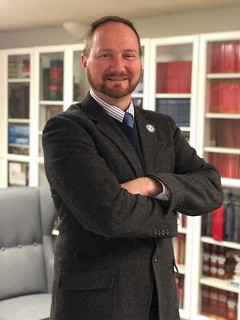 In 2020 things looked dicey for book publishing. Starting that March, when libraries and brick-and-mortar businesses were shutting down because of COVID-19, American bookstores experienced 12 consecutive months of falling sales. This is finally turning around—and with gusto. Today the world of books is bustling.
In 2020 things looked dicey for book publishing. Starting that March, when libraries and brick-and-mortar businesses were shutting down because of COVID-19, American bookstores experienced 12 consecutive months of falling sales. This is finally turning around—and with gusto. Today the world of books is bustling.
The U.S. Census Bureau estimates that bookstore sales increased 35 percent in March 2021, benchmarked against March 2020. Publishers Weekly reported that unit sales of print books rose 25 percent in the week ending May 8, compared to the same week in 2020. Adult nonfiction—which is the category most numismatic books occupy—jumped 25.1 percent compared to one year ago.
In our cozy corner of the publishing world, nestled within antiques and collectibles, sales are strong. We've seen a surge in numismatic purchasing this year. We had to crank the presses back up when several new books quickly sold out of their initial print runs in the first quarter. These included specialized as well as beginner books, and new titles as well as updated/revised editions of popular older books. Here are a few of the strong sellers:
- A Guide Book of Continental Currency and Coins (Q. David Bowers)
- A Guide Book of United States Currency, 8th edition (Kenneth Bressett)
- United States Gold Counterfeit Detection Guide (Bill Fivaz)
- Check List and Record Book of United States and Canadian Coins
- A Guide Book of Gold Eagle Coins, 2nd edition (Bowers)
- A Guide Book of U.S. Paper Money, 7th edition (Arthur and Ira Friedberg)
Where is this increased demand coming from? The COVID pandemic explains some of it. Locked down without movie theaters, concerts, restaurants, shopping malls, and other traditional distractions, Americans have been reading. We've also returned to our classic hobbies, a scenario that hearkens back to the Great Depression. Coin collecting enjoyed a boom in the 1930s when everyday Americans found it was a fun, affordable, and easy-to-begin pastime. Coin boards, folders, books, albums, and similar hobby supplies became hot commodities—much as they are today.
To read the complete article, see:
Notes published: Looking back, and ahead
(http://news.coinupdate.com/notes-published-looking-back-and-ahead/)
DANIEL ALLEN FREELAND (1949-2021)
Pete Smith submitted this remembrance of Dan Freeland. Thank you. -Editor
 I was shocked to see the death notice for Dan Freeland in the June issue of The Numismatist. I see that he died on April 17. I had talked with him on the phone less than a month earlier. His obit mentions that he was a teacher for thirty years but fails to mention that he graduated from Central Michigan University.
I was shocked to see the death notice for Dan Freeland in the June issue of The Numismatist. I see that he died on April 17. I had talked with him on the phone less than a month earlier. His obit mentions that he was a teacher for thirty years but fails to mention that he graduated from Central Michigan University.
On March 20, I got an email message from Kathy Freeland. She said that she and Dan had watched my presentation for the Newman Numismatic Portal Symposium. She asked for my phone number so Dan could call me. He called and we talked about phone cards and other topics.
It was probably at least twenty-five years ago when I first met Dan. He was a Central States exhibitor and exhibit judge. He had an exhibit on national commemorative medals which is an interest we shared. I recall later he had award winning exhibits on Michigan National Bank Notes. He won a first-place award for his exhibit of Michigan Nationals as recently as 2018 in Philadelphia.
Kathy Freeland was also an exhibitor and judge. The first exhibit I recall for her was on women's badges issued for ANA conventions. Later I got to work with her as Secretary for TAMS. Dan and Kathy received an ANA Presidential Award in 2009.
There were probably years when I saw Dan and Kathy at shows at least three times. I didn't talk with them every time, but they seemed to always be around.
To read Dan's online obituary, see:
Daniel Allen Freeland of Mayville, Michigan | 1949 - 2021 | Obituary
(https://www.avramfuneralhome.com/obituary/daniel-freeland)
NNP LAUNCHES NUMISMATIC NOTABLES
The Newman Numismatic Portal has launched a new video interview series. Project Coordinator Len Augsburger provided the following report. -Editor
Newman Portal Launches Numismatic Notables
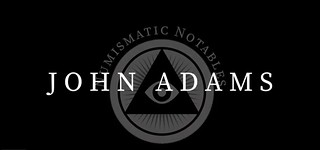 Newman Portal announces a new video series, Numismatic Notables, produced by Lianna Spurrier, which will feature interviews with important personalities in the field of numismatics. Our first interviewee, John Adams, was interviewed by Len Augsburger and Joel Orosz on February 19, 2021, and brings a lifetime of collecting experiences beginning with David Bullowa, the Philadelphia dealer, and continuing to the present day. Along the way Adams has written a number of now-standard works including United States Numismatic Literature (vols. I-II), Comitia Americana and Related Medals, and Medallic Portraits of Admiral Vernon.
Newman Portal announces a new video series, Numismatic Notables, produced by Lianna Spurrier, which will feature interviews with important personalities in the field of numismatics. Our first interviewee, John Adams, was interviewed by Len Augsburger and Joel Orosz on February 19, 2021, and brings a lifetime of collecting experiences beginning with David Bullowa, the Philadelphia dealer, and continuing to the present day. Along the way Adams has written a number of now-standard works including United States Numismatic Literature (vols. I-II), Comitia Americana and Related Medals, and Medallic Portraits of Admiral Vernon.
Adams reflects on numismatic characters of all stripes, including John Ford, Doug Smith, William Sheldon, and others. Adams was the only person to ever confront Sheldon on the matter of the large cents stolen from the American Numismatic Society, a conversation recounted by Adams in this interview. Adams has played a leadership role in many numismatic organizations and opines on the role of institutions within numismatics, including the American Numismatic Society and Massachusetts Historical Society. Adams is further active in the Medal Collectors of America and the Numismatic Bibliomania Society, and offers thoughts on the importance of social engagement within the collector community.
Link to Numismatic Notables: John Adams on Newman Portal:
https://nnp.wustl.edu/library/book/599709
VIDEO: A THOUSAND OUNCE BAR OF SILVER
These are selections from the David Lisot Video Library that feature news and personalities from the world of coin collecting. David has been attending coin conventions since 1972 and began videotaping in 1985. The Newman Numismatic Portal now lists all David's videos on their website at:
https://nnp.wustl.edu/library/multimediadetail/522852
Last week's video covered the world's largest silver coin; here's one on a thousand ounce bar of silver. -Editor
Have You Ever Seen a 1000 Oz Bar of Silver?
VIDEO: 2:45.
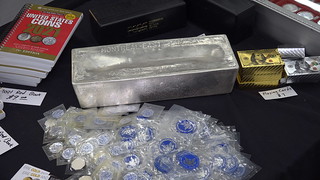 Ashley Sandoval, Erie Gold & Silver,
Ashley Sandoval, Erie Gold & Silver,
David Lisot, Interviewer, CoinTelevision.com. May 7, 2021.
Imagine a thousand ounce bar of silver! Imagine trying to lift it with one hand! Collectors at the Denver Coin Expo had that challenge to lift a silver bar weighing almost 80 pounds and valued more then $28,000. Going to a coin show is one of the best ways to see amazing numismatic items.
An excerpt of the video is available for viewing on the Coin Television YouTube Channel at:
https://youtu.be/HgXy9ekGBq8
To read the earlier E-Sylum article, see:
VIDEO: LARGEST SILVER COIN IN THE WORLD
(https://www.coinbooks.org/v24/esylum_v24n21a09.html)
NOTES FROM E-SYLUM READERS: MAY 30, 2021
Using IKMKRegarding IKMK, the new database of coins in German and Austrian public collections, Max Hensley writes:
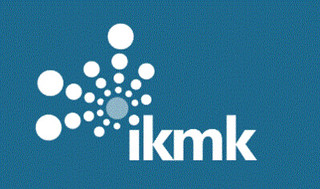 "I tried the newly-launched IKMK museum coins website. I entered
"I tried the newly-launched IKMK museum coins website. I entered Siebenburgen 20 Kreuzer
(Transylvania), which was obscure enough to be a good test and relevant to likely Austrian holdings. The return was a single coin, a very rare 10 Kreuzer. So the website has some degree of flexibility in that it substituted another denomination. Oddly it did not return any of the "common" (relatively) coins of this principality. One doesn't know whether these are missing from the museum holdings or the search engine was lacking.
The site was easy to use and the image (obverse and reverse) of the 10 kreuzer was very good. It was a real treat. In 55 years of collecting this material I had never seen another. I still collect some European coins. It's been a bit fruitless the last decade or so as nobody offers anything I've not already seen - and when they do, it's 4 figures. I've migrated over to scripophily, which is a far better deal from the point of view of rarity and prices (which are laughably low considering populations).
IKMK is quite a contrast to the Smithsonian effort. I hope they consider the IKMK site to be something to shoot for."
The site was slow to load the coin's page for me, but the link below will take you to it. It's nicely done. Above are lower-resolution versions of the coin images. -Editor
To visit the IKMK site, see:
https://ikmk.net/
Haus Österreich: Joseph II.
1770
(https://www.ikmk.at/object?id=ID357503)
To read the earlier E-Sylum article, see:
IKMK: CATALOG OF GERMAN AND AUSTRIAN COINS
(https://www.coinbooks.org/v24/esylum_v24n21a12.html)
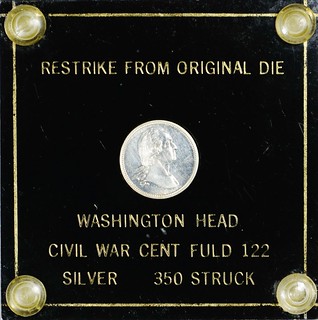 Regarding Bill Groom's question about a restruck Fuld Die 122/123 token,
Richard Lobel writes:
Regarding Bill Groom's question about a restruck Fuld Die 122/123 token,
Richard Lobel writes:
"The Washington silver piece was struck by the late Robert Bashlow and David Laties of Educational Coin Co., N.Y."
Thank you! -Editor
To read the earlier E-Sylum article, see:
NOTES FROM E-SYLUM READERS: MAY 23, 2021 : Fuld Die 122/123 Silver Restrike Token
(https://www.coinbooks.org/v24/esylum_v24n21a11.html)
David Hoover writes:
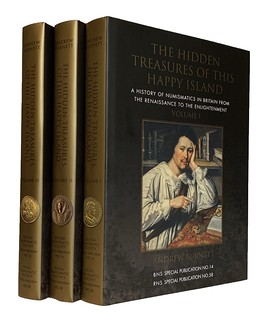 "Some time ago there was a discussion in The E-Sylum about the term testoon and whether it was the same as the shilling which came along shortly after testoons were discontinued.
"Some time ago there was a discussion in The E-Sylum about the term testoon and whether it was the same as the shilling which came along shortly after testoons were discontinued.
"I am working my way through the massive trilogy "The Hidden Treasures of This Happy Island" and noted that Andrew Burnett stated the term testoon came from Italian.
"It appears the Italian coin was a testone, which was adopted in France and possibly other 15th and 16th century European usages. The English then apparently went with the idea and introduced the testoon. This kind of reinforces my idea that a testoon was not really the same as a shilling even though I am sure the matter remains of dispute. Of course, shilling seems to come from Old English scilling meaning a 20th of a pound. It is just that its use as a coin name came after testoon."
Thank you. I haven't seen Andrew's book set yet, but it sounds like a great work. -Editor
To read earlier E-Sylum articles, see:
NOTES FROM E-SYLUM READERS: OCTOBER 7, 2018 :
Testoons and Shillings
(https://www.coinbooks.org/v21/esylum_v21n40a08.html)
NOTES FROM E-SYLUM READERS: OCTOBER 14, 2018 :
More on Testoons and Shillings
(https://www.coinbooks.org/v21/esylum_v21n41a09.html)
CHARLES DAVIS NEW TITLES IN STOCK
(https://www.coinbooks.org/v24/esylum_v24n01a03.html)
Tom Caldwell of Northeast Numismatics writes:
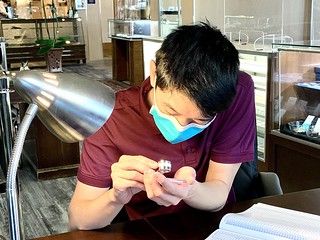
"In the absence for the second year in a row of the ANA summer seminar, Seth Chandler from Witter Coin in San Francisco should be congratulated for filling in the void to a certain degree. 25 lucky young ones aged 13 to 21 will be chosen to attend all expenses paid. There is an appeal for funds that I think many of your readers will be willing to help out with."
As of this writing 46 supporters have kicked in to raise about half of the required funds. Please do consider a donation for the next generation of numismatists. See: https://www.wittercoinfund.com/ . -Editor
To read the earlier E-Sylum article, see:
COIN UNIVERSITY PROGRAM IN SAN FRANCISCO
(https://www.coinbooks.org/v24/esylum_v24n21a17.html)
Regarding a catalog titled "List of Coins Attached to NUMISMATIC URN, collected by Edward J Rausch", Dave Hirt writes:
 "Mr Rausch says that this project has taken "the best part of a lifetime. It consists of a collection of rare coins fastened to a large copper urn." The urn is completely covered with this collection. The description of each coin can be read." The coins are fastened to the urn with solder and bolts, and each coin can be removed without injuring its condition."
"Mr Rausch says that this project has taken "the best part of a lifetime. It consists of a collection of rare coins fastened to a large copper urn." The urn is completely covered with this collection. The description of each coin can be read." The coins are fastened to the urn with solder and bolts, and each coin can be removed without injuring its condition."
"There are coins from the Christian era down to the present time in many different metals.
"The catalog is 39 pages, listing all the coins on the urn. This was the method of one man to show his collection. I believe that this catalog was printed around 1910 (no date on it)."
"The collection of Mr Rausch was sold by Tom Elder in two sales in 1938. No mention is made of the urn.
"I only saw this catalog sold one other time. That was in a David Sklow sale some years ago. It realized $20.
Great numismatic Americana! I don't believe I've ever seen this catalog.
Gengerke lists just the two sales for Edward Rausch, both by Thomas Elder in 1938 (February 26 and May 14). The February sale lists "Siege and Necessity and Other Curious Coins from the E. Rausch Collection." The May sale is Part II of the consignment. "Mr. Rausch collected this odd and curious collection of Siege Pieces, Klippes, Siege Pieces, Necessity Coins etc. between the years 1881 and 1903." Both are digitized by the Newman Numismatic Portal. I did not see mention of the urn either.
If each coin could indeed be "removed without injuring its condition", then perhaps some coins in the Elder sales came from the urn. -Editor
DOLLAR BILLS AS MESSENGERS
Jeff Kelley of Massachusetts submitted these thoughts on banknotes autographed by notable people. -Editor
I was very interested to read the latest article on banknotes that have political or other messages written or stamped on them.
I was reminded of my own efforts some years ago to use currency to promote an awareness of certain historical achievements or events.
I decided that one way to guarantee at least some level of curiosity among recipients of the dollar bills was to have them autographed by notable people whose activities I felt were worthy of further study, especially by students.
My project lasted a few years and I was able to enlist the participation of over a dozen notable people from a variety of fields. I used $1 bills except for one or two occasions when I sent $2 bills. I usually sent five banknotes to each person, although I sometimes reduced that to three if I felt it was too much of an imposition for a particular celebrity. My intention, as explained to the people I wrote to, was to keep one example for myself and spend the rest. My hope was that as the banknotes circulated they would spark the curiosity of recipients and that they might research the people whose signatures appeared on the notes.
The first focus of my project was German boxer Max Schmeling. His was a remarkable story that was interwoven with the horrors of WWII.
Schmeling held the world heavyweight championship title from 1930-1932, and during his boxing career he faced American boxer Joe Louis twice, knocking him out once in a non-championship fight.
Schmeling, who refused to join the Nazi Party, was conscious of the fact that his success in the 1930s might be used for propaganda purposes by Adolf Hitler. He lost his 1938 title match to Joe Louis and years later expressed satisfaction at the outcome because his loss denied the Nazis a propaganda victory. Schmeling and Louis later became good friends and Schmeling even paid for Louis's funeral in 1981.
It was only revealed very late in Schmeling's long life that as WWII was unfolding he saved two Jewish children by hiding them in his Berlin apartment until they could be safely evacuated.
Here is one of the Max Schmeling dollar bills, signed when he was 97.
To read the earlier E-Sylum article, see:
NOTES FROM E-SYLUM READERS: MAY 23, 2021 : Trump 2020 Graffiti Note
(https://www.coinbooks.org/v24/esylum_v24n21a11.html)
VOCABULARY TERM: EDGE LETTERING, PART 3
Here's more from the entry on Edge Lettering and Numbering from Dick Johnson's Encyclopedia of Coin and Medal Terminology. -Editor
Data Found On Edges
Hallmarks. Hallmarking developed to a high degree among English gold and silversmiths, beginning as early as the 13th century. Four marks usually appeared on English silver and gold: a maker's mark, the hallmark of the assay office, a date letter and a sterling mark. All precious metal objects were required by law to be so hallmarked (with certain exceptions such as foreign-made plate or antique objects over 100 years old). Usually these appear on the reverse, but infrequently on the obverse – or the edge. See hallmarks and hallmarking.
Gold and silver objects made in America were frequently hallmarked but no uniform system of symbols was ever adopted. Beginning in the early 19th century, British craftsmen began using words to replace the symbols, and this carried over somewhat to America and other countries.
Standard became widely known for 900 parts silver to 100 parts copper. Coin standard or coin silver was also used for the same meaning, more so in America than in England. (Silver coins were actually melted for the source of this silver, but not always so.)
Sterling meant 925 parts of silver to 75 parts of copper; and this term is universally known as such to this day.
Gold was expressed in karats – 24 being pure gold. Karats was abbreviated "kt" and an example, "18 kt" means 750 parts of gold to 250 parts alloy, usually copper. The most popular karat fineness ranges from 9 through 22.
Medals made of rolled gold usually carry a fraction on the edge: "1/10 18 kt." for example, means there is 1/20th of the thickness of the piece of 18 karat gold on one side, 1/20th on the other side (this adds up to the total 1/10 expressed on the edge). The base metal is a lesser alloy, again, usually copper.
Fineness. In 1904 standard marks were legalized for the decimal equivalents of fineness for silver objects in the United Kingdom. Largely due to the influence of Tiffany & Co., the New York jewelry firm, a similar law was enacted in the United States in 1906. These laws requiring every precious metal item made or sold in the two countries to be marked with its fineness.
Gold and silver medals manufactured since 1906, therefore, are required to give a karat rating for gold, or a fineness statement for silver. Recognized words, or the exact decimal equivalent, are permitted. Today silver medals are edge marked "sterling" or ".925" – or ".999" for commercially pure silver – the two most popular compositions of silver.
Fineness may be expressed in other ways, as a fraction, for example: 900/1000, but this is discouraged because this is one form of expressing a serial number and edition limits on collector medals.
Serial numbers. These numbers are often a single figure. This can be the case for open-ended editions (as many medals are made as are sold by a certain date), or for an edition which is announced in advance but not expressed on the medals.
Most often, however, a pre-determined edition limit is expressed thusly: 325/1500. This means it is the 325th medal of an edition of 1,500 pieces. It does not necessarily mean it is the exact 325th specimen struck from the die of that design, for frequently numbering is interrupted. That is, to meet a shipping date or other commitment, medals may be numbered out of sequence to fulfill an allotment.
Infrequently the entire announced limit is not sold out and serial numbers may have gaps in their sequence – a permanent example of interrupted numbering. (This data is kept in a registry.)
To read the complete entry on the Newman Numismatic Portal, see:
Edge Lettering and Numbering
(https://nnp.wustl.edu/library/dictionarydetail/515813)
To read the earlier E-Sylum article, see:
VOCABULARY TERM: EDGE LETTERING, PART 2
(https://www.coinbooks.org/v24/esylum_v24n21a13.html)
MORE ON DAVID ULYSSES PROSKEY (1853-1928)
Here's the final section from the David Proskey entry from the online draft of John Lupia's book of numismatic biographies. Thanks! This is an excerpt with the full article and bibliography available online. -Editor
 In 1900, he is listed in the U. S. Census as a coin dealer still living at 448 River Street, Paterson, Passaic County, New Jersey, with his wife, three sons and daughter.
In 1900, he is listed in the U. S. Census as a coin dealer still living at 448 River Street, Paterson, Passaic County, New Jersey, with his wife, three sons and daughter.
At the Collector's Club, 351 Fourth Avenue, New York City, New York. The first public numismatic exhibition held at the Collector's Club took place on Saturday, January 25th 1902. This exhibit was comprised of collections of five exhibitors : John G. Mills, David U. Proskey, Charles Gregory, Albert R. Frey, and H. G. Mandel. Proskey won first place in the exhibit and Gregory took second place.
Harlan Page Smith died on Sunday, March 2, 1902, just sixteen days short of his sixty-third birthday and ninety-five days after the dissolution of his partnership with David Proskey in New York Coin and Stamp Company.
In mid-April Proskey quickly held a coin sale whose date was not fixed at the time of printing the April 1902 issue of The Numismatist.
In May 1902 a poem was written about Proskey and was published in June issue The Numismatist.
Corneliuett Smith brought a lawsuit against David Proskey for losses as administratrix of the estate in 1902. Apparently Proskey kept the four safes filled with coins, medals, accounting ledgers, etc. formerly belonging to the New York Coin and Stamp Company, which were supposed to be given to Smith or his estate. The safes and their contents were estimated to be valued at $15,000. Mrs. Smith sued for that amount plus an additional $1,000 in legal fees. Mrs. Smith won the case. David Proskey appealed to the Supreme Court of Appeals. This lawsuit went back and forth filing motion after motion in a long protracted hearing, which always seemed to skirt the real issue of Mrs. Smith is that she had neither any inventory of the safes, nor way of knowing who owed her husband's company money nor how much, which Proskey had access to the four safes knowing the combinations; and consequently no objective authoritative accounting existed for her peace of mind and was forced to merely take Proskey at his word. Mrs. Smith was keenly aware of the value of rare coins, gold coins, etc., which she knew filled the safes, besides outstanding invoices of buyers who owed the firm money.
In 1910, he is listed in the U. S. Census as a coin dealer still living at 448 River Street, Paterson, Passaic County, New Jersey, with his wife daughter and brother-in-law Walter Van Houten.
In 1920, he is listed in the U. S. Census as a dealer in stamps and coins living at 61 Mountain Avenue, North Caldwell, New Jersey, with his wife, son David, and daughter Elsie and son-in-law Charles.
He joined the ANA in 1923 and is member no. 2459. He was also a member of the New York Numismatic Club.
George H. Clapp, as reported years later in Penny Wise, called him the most knowledgeable source on large cents he had ever met.
He died on August 16, 1928. His son David Verus Proskey continued the family run business.
Martin Luther Beistle made tribute to Proskey publishing a halftone photograph portrait of him in the classic work A Register of Half Dollar Varieties and Sub-Varieties (1929).
There were eight posthumous coin auction sales liquidating the coin collection of David Proskey that were held by Stack's from Stack's sale No. 24, January 27, 1939 to sale No. 64, March 27, 1943.
To read the complete article, see:
PROSKEY, DAVID ULYSSES
(http://www.numismaticmall.com/numismaticmall-com/proskey-david)
To read the earlier E-Sylum article, see:
MORE ON DAVID ULYSSES PROSKEY (1853-1928)
(https://www.coinbooks.org/v24/esylum_v24n21a14.html)
STACKS BOWERS JUNE 2021 SALE SELECTIONS
Here are some lots that caught my eye in the upcoming June 2021 Stack's Bowers sale. See also the article elsewhere in this issue about the National Bronze Picture Gallery medals. -Editor
Lot 1069: 1902 Life Saving Benevolent Association of New York Medal
1902 Life Saving Benevolent Association of New York Medal. By George Hampden Lovett. Gold. Prooflike Mint State.
51.1 mm. 802.7 grains, fineness unknown. Obv: Sailing ship foundering in storm, House of Refuge on shore dispatches rescuers in life boat while others fire a lifeline from a Lyle Gun on the beach. Rev: Oak wreath at border, inscription VITA FELICIBUS AUSIS SERVATA above, center inscribed to the recipient PRESENTED TO / CAPTAIN A. POTJER / OF S.S. POTSDAM IN RECOGNITION / OF HIS HUMANITY AND SEAMANSHIP / IN RESCUING THE OFFICERS AND / CREW OF THE FOUNDERING / BARK "BISHOP BRUN" / IN A HIGH CROSS SEA. MID- / ATLANTIC OCEAN / JUNE 25, 1902. Deeply mirrored in the fields, this beautiful bright medium golden specimen exhibits only the typical light handling marks for an awarded example. While we have handled a few gold medals of this type in recent years, they are clearly far rarer than their silver and bronze counterparts.
A great, seldom-seen Lovett piece. -Editor
To read the complete lot description, see:
1902 Life Saving Benevolent Association of New York Medal. By George Hampden Lovett. Gold. Prooflike Mint State.
(https://auctions.stacksbowers.com/lots/view/3-RELPN/1902-life-saving-benevolent-association-of-new-york-medal-by-george-hampden-lovett-gold-prooflike-mint-state)
Lot 1073: 1919 Carnegie Hero Fund Medal
1919 Carnegie Hero Fund Medal. Bronze. Mint State.
76.2 mm. Obv: Frock-coated Andrew Carnegie bust to the right, inscriptions CARNEGIE HERO FUND above and ESTABLISHED APRIL 15TH 1904 below. Rev: Outline map of North America, arms of old Canada (four provinces), Newfoundland (then a separate Crown Colony) and the U.S. around a cartouche inscribed to the recipient ROBERT W. JACQUES / WHO SAVED / HAROLD R. EDER / FROM DROWNING / LAKETON, PA. / JULY 27, 1919.
A nice earlier example; the fund began awarding medals in 1904. There are two other Carnegie Hero Medals in the sale, including a silver one from 1920. -Editor
To read the complete lot description, see:
1919 Carnegie Hero Fund Medal. Bronze. Mint State.
(https://auctions.stacksbowers.com/lots/view/3-RELQF/1919-carnegie-hero-fund-medal-bronze-mint-state)
Lot 1215: Bar Copper
Rare Choice Mint State Bar Copper
The Harlan P. Smith Specimen
Undated (ca. 1785) Bar Copper. W-8520. Rarity-4. MS-64 BN (PCGS).
Here is a fascinating example of this classic early federal era type, with superior quality, outstanding eye appeal, and a famous provenance. It was offered as lot 46 in S.H. and H. Chapman's May 1906 sale of the Harlan P. Smith Collection, where it was cataloged as: "Uncirculated. Partly bright red. Rare." While we suspect that this coin may have mellowed a bit in the 100+ years since its appearance in that sale, plenty of vivid pinkish-orange mint color remains on the reverse within the protected areas between the bars.
One of the most eagerly sought numismatic items from the colonial and early federal era of United States history, the Bar copper is also one of the most enigmatic. We are not sure by whom or under what circumstances these pieces were produced. We are reasonably sure, however, that this type was struck circa 1785, as evidenced by an entry in the November 12, 1785, issue of the New Jersey Gazette ...
Nice coin, with a great provenance. -Editor
To read the complete lot description, see:
Undated (ca. 1785) Bar Copper. W-8520. Rarity-4. MS-64 BN (PCGS).
(https://auctions.stacksbowers.com/lots/view/3-REN3Z/undated-ca-1785-bar-copper-w-8520-rarity-4-ms-64-bn-pcgs)
Lot 2479: 1813 Half Eagle
This piece is traceable back more than 42 years to our (Stack's) sale of October 1979 and is now, once again, available to collectors in the modern numismatic market. As a series, the Capped Head Left half eagles struck from 1813 to 1834 are among the most elusive in all of U.S. numismatics. Most examples are from the first year, 1813, having been set aside by the contemporary public due to the novelty of the design. Most other dates and varieties are rare, if not non-collectable, since rising gold prices resulted in the wholesale destruction of pre-1834 U.S. gold coins through the mid 1830s. At the Choice Mint State level, the 1813 half eagle remains considerably scarce and is eagerly pursued by collectors.
Provenance: From our (Stack's) sale of October 1979, lot 110; our sale of the Naples Bay Collection, November 2020 Auction, lot 9177.
Beautiful piece. -Editor
To read the complete lot description, see:
1813 Capped Head Left Half Eagle. BD-1. Rarity-2. MS-63 (PCGS).
(https://auctions.stacksbowers.com/lots/view/3-REUIV/1813-capped-head-left-half-eagle-bd-1-rarity-2-ms-63-pcgs)
Lot 2528: 1801 Eagle
The 1801 BD-2 variety represents the only use of this obverse die and the first of two uses of this reverse die. The large, thin obverse stars are diagnostic of this die marriage, as the BD-1 pairing of this issue has large, thick stars. The obverse and reverse dies of this variety proved unusually hardy by the standards of the early eagle series, both striking 30,000 to 40,000 coins in this pairing and the reverse going on to produce an additional 7,500 to 10,000 coins in the 1803 BD-3 marriage.
John W. Dannreuther (2006) estimates that only 600 to 800 coins are extant from the 1801 BD-2 dies, the vast majority of which are in higher AU and low end Mint State grade up through MS-62. This variety becomes a notable rarity at the Choice Uncirculated level. The present near-Gem represents a significant opportunity, and is fit for a world-class cabinet or Registry Set.
PCGS Population (both die varieties of the issue): 37; 4 finer (MS-65 finest).
Another beautiful piece of early gold. Amazing that these survived the melting pot. -Editor
To read the complete lot description, see:
1801 Capped Bust Right Eagle. BD-2, Taraszka-25. Rarity-2. MS-64 (PCGS).
(https://auctions.stacksbowers.com/lots/view/3-REV01/1801-capped-bust-right-eagle-bd-2-taraszka-25-rarity-2-ms-64-pcgs)
Lot 3165: 1973 CIA Honorable Service Medal
1973 Central Intelligence Agency Honorable Service Medal. Bronze. Mint State.
74 mm. Obv: CIA shield with inscriptions CENTRAL INTELLIGENCE AGENCY above, UNITED STATES OF AMERICA on a ribbon below. Rev: Demi wreath to left with inscription FOR / HONORABLE / SERVICE above a ribbon inscribed to the recipient ISABEL M. PETERSON / 1953-1973. Edge: MEDALLIC ART CO. N.Y. BRONZE 1527. Embedded in a 100 mm x 100 mm x 32 mm Lucite desk ornament/paperweight.
A seldom-seen product of Medallic Art Co. -Editor
To read the complete lot description, see:
1973 Central Intelligence Agency Honorable Service Medal. Bronze. Mint State.
(https://auctions.stacksbowers.com/lots/view/3-RFRVE/1973-central-intelligence-agency-honorable-service-medal-bronze-mint-state)
Lot 3174: 1971 Western Reserve Numismatic Club Countermark
1971 Western Reserve Numismatic Club Countermark on a 1921 Morgan Silver Dollar. MS-63 (NGC).
According to the article, "Western Reserve Numismatic Club Counterstamps", one 1921 Morgan dollar was countermarked for each member of the club at the time, somewhere on the order of 50 to 100 pieces, but the exact number is unknown. The majority are Philadelphia Mint coins, as here, but a few Denver and San Francisco pieces are also known.
Numismatic ephemera of sorts - a nice counterstamp on a nice coin, turning a common item into a rare souvenir. -Editor
To read the complete lot description, see:
1971 Western Reserve Numismatic Club Countermark on a 1921 Morgan Silver Dollar. MS-63 (NGC).
(https://auctions.stacksbowers.com/lots/view/3-RFRX7/1971-western-reserve-numismatic-club-countermark-on-a-1921-morgan-silver-dollar-ms-63-ngc)
LUGDUNUM AUCTION 21 HIGHLIGHTS
Dr Jonas Emmanuel Flueck of Lugdunum GmbH in Switzerland passed along information about his firm's upcoming auction. Thanks. Here's text from the catalogue's Foreword. As noted in the earlier article, there are some magnificent medals in this sale. -Editor
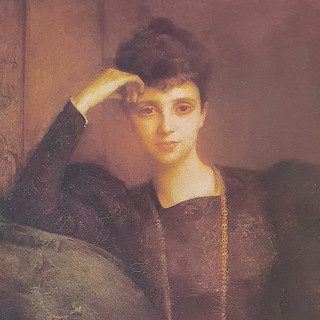 It is a great honor and a great pleasure for us to have the opportunity to offer in this auction a group of exceptional medals from the Collection of Martine, Comtesse de Béhague (1870-1939), one of the most important French art collectors, numismatists and benefactors of the early 20th Century.
It is a great honor and a great pleasure for us to have the opportunity to offer in this auction a group of exceptional medals from the Collection of Martine, Comtesse de Béhague (1870-1939), one of the most important French art collectors, numismatists and benefactors of the early 20th Century.
For any connoisseur, numismatist or art collector, artefacts with a provenance from her famous collection are of the greatest desire. The Comtesse did only collect the best pieces of Art available at her time and that is the reason why this provenance is considered as a guaranty of great artistic merit, rarity and good taste.
This group of medals is made of six specimens, that we would like to introduce in a few words:
The first medal (lot n°48) is an extremely rare silver medal struck in 1455 by the French King Charles VII (1422-1461). Also called Calaisienne, it commemorates the end of the Hundred Years' War and the following expulsion of the English from the French territory. Of the highest historical importance and of great artistic merit, it appeared for the last time on the market almost a century ago, in December 1921.
The second medal (lot n°53) is an unpublished gold medal of François de France, Duc d'Anjou (1555-1584). Cast in 1580, it must be linked to the Treaty of Plessis-lès-Tours that took place in September 1580 and paved the way to the formal independence of the United Provinces or Dutch Republic.
The third medal (lot n°58) is a very artistic gold medal for Maria de Medici (1610-1614) attributed to the famous French sculptor Guillaume Dupré (1576-1643). Cast somewhere between 1610 and 1614, it is a masterpiece of medallic art in very high relief illustrating to perfection the opulence and ambition of the French Queen.
The fourth medal (lot n°59) is a large gold medal (116 g.) for the French King Louis XIII (1610-1643) signed by Guillaume Dupré. Cast in 1623 to commemorate the quell of the first Huguenot Rebellion, it is an extremely rare testimony of the great riches of the first half of the 17th Century.
The fifth medal (lot n°96) is a very rare gold medal of the Tudor King Henry VIII (1509-1547) struck in London in 1545. Also known as the Supremacy Medal, it commemorates the assumption by the King of the title of Supreme Head of the Church of England and is considered as the first English commemorative medal ever minted.
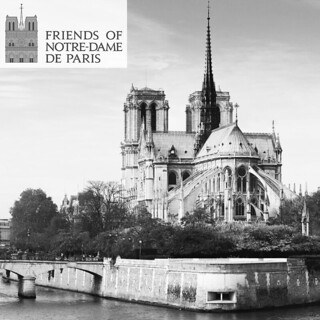 The sixth medal (lot n°142) is a 5 Goldgulden piece from Hildesheim (Germany) struck in 1528. It was mounted, probably at the beginning of the 17th century, in a very well decorated pendant with pearls and enamel.
The sixth medal (lot n°142) is a 5 Goldgulden piece from Hildesheim (Germany) struck in 1528. It was mounted, probably at the beginning of the 17th century, in a very well decorated pendant with pearls and enamel.
Finally, we are very pleased to mention that the consignor, owner by descent of these medals, has generously decided to donate the proceeds of the sale of this group (as well as of lot n°137) to support the reconstruction and restoration of the Cathedral Notre-Dame de Paris.
To read the complete catalogue online:
https://lugdunum.auex.de/img/lose/Kataloge/Auktion_21/index.html
In addition to the Calaisienne medal discussed earlier, are now three additional videos on the site. -Editor
To watch the videos:
The Supremacy Medal
(https://www.lugdunum-numismatik.com/en/supremacy-medal)
The Justitia Medal
(https://www.lugdunum-numismatik.com/en/justitia-medal)
The Medal of splendour
(https://www.lugdunum-numismatik.com/en/medal-opulence)
To read the earlier E-Sylum article, see:
DR JONAS FLUECK FORMS LUGDUNUM GMBH
(https://www.coinbooks.org/v21/esylum_v21n47a15.html)
THE 1455 CALAISIENNE MEDAL OF CHARLES VII
(https://www.coinbooks.org/v24/esylum_v24n10a19.html)
NUMISMATIC NUGGETS: MAY 30, 2021
Here's a selection of interesting or unusual items I came across in the marketplace this week. Tell us what you think of some of these. -Editor
Croton was founded by Achaean Greeks in c. 710 BC. It was situated between Tarentum and Rhegium making it a good port city between the two. Some notable Greeks found prominence in Croton. The first was Milo of Croton, who was victorious in the Olympic Games c. 588 BC. The philosopher Phythagorus formed a society of over 300 disciples.
This lovely coin comes from the Niggeler Collection (sold in 1965) through a joint venture of Bank Leu and M&M Basel and previously was part of the Jameson Collection.
Shanna Schmidt's Coin of the Week has an unusual plain design - a tripod with the feet of a griffin. -Editor
To read the complete item description, see:
Bruttium, Croton. c. 500-480 BC
(https://www.shannaschmidt.com/greek-coins/bruttium-croton-c-500-480-bc?rq=gk1522)
Sicily, Siculo Punic, Panormos (c. 320 BC) AR Tetradrachm, 16.40g. Male charioteer driving a fast quadriga left, Nike flying right, crowning charioteer; Punic ZIZ between two dolphins in exergue. Rev. Head of Arethusa right wearing a necklace of pearls, four dolphins around. (Jenkins (1971), 76-77 (O21/ R63). Lustrous. Extremely Fine.
A beautiful coin - item #12 from the Baldwin's Summer price list. -Editor
To read the complete price list, see:
https://www.baldwin.co.uk/wp-content/uploads/2021/05/BALDWINS_FPL_SUMMER_2021_SM2.pdf
Breton-925, Breen-1084 variety, the rare variant struck in Copper. Holed at the top for suspension, as usual. Believed by us to be High Rarity-6.
And this is a spectacular example with hard, lustrous, medium brown surfaces and extremely sharp detail far beyond what is normally encountered on a type most often seen well worn and/or with some degree of environmental damage.
Ex Henry Chapman's June 1907 sale of the Matthew A. Stickney Collection, lot #2941.
Beautiful piece, with a great provenance. I've never seen a piece with such great detail. From John Agre's Coin Rarities Online. -Editor
To read the complete item description, see:
1820 North West Co. Token
(https://www.coinraritiesonline.com/product/1820-north-west-company-token-4/)
An exceptionally preserved example of this rare and popular branch mint gold issue from the Charlotte mint! One of the final years of production that resulted in a mintage of just under 32,000 pieces. Nearly all of the mintage entered circulation as America teetered on the verge of the Civil War. From a population of four only five PCGS examples have been graded finer than the present example.
Gotta love a nice branch mint gold coin. From David Lawrence Rare Coins. -Editor
Perth Mint June 2021 Releases
Itchy & Scratchy
2021 1oz Silver Proof Coloured Coin
Fans celebrating The Simpsons with our officially licensed coin series will be delighted by this exciting 1oz silver coloured addition featuring the logo from The Itchy & Scratchy Show. Looking stunning in its upright acrylic display case, this limited-edition piece will be highly sought after among the massive global audience which has enjoyed The Simpsons since it premiered in 1989.
Dreaming Down Under – Koala
2021 1/2oz Silver Proof Coloured Coin
Following the initial Kangaroo coin, the second release from our Dreaming Down Under Series of 1/2oz silver coloured coins features Australia's sleepiest animal – a young Koala. Its endearing artistry, including native Australian flowers and other wildlife, makes the coin a perfect gift.
We don't often discuss modern issues but I thought I'd mention these colorized pieces from The Perth Mint that I saw in a press release this week. I don't know what would possess a numismatist to acquire some of these, but clearly there's a market for them. I wouldn't blame a Simpson's fan for wanting an Itchy & Scratchy coin, and that koala IS cute. My wife collects elephants, and there must be people who collect cute koalas, too. -Editor
ANCIENT AMULET: SOLOMON'S SEAL
This one's not numismatic, but close enough and interesting nonetheless. It's an ancient amulet called 'Solomon's Seal' -Editor
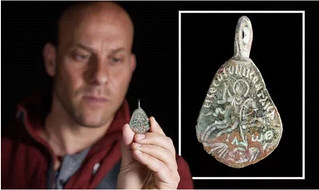 ISRAELI archaeologists have highlighted the discovery of a 1,500-year-old amulet believed to have once protected women and children from the "evil eye".
ISRAELI archaeologists have highlighted the discovery of a 1,500-year-old amulet believed to have once protected women and children from the "evil eye".
The ancient trinket was unearthed in northern Israel in the Biblical region of Galilee, near the Sea of Galilee. Tova Haviv, one of the first residents of the village of Arbel stumbled upon the necklace pendant some 40 years ago. A family member has now handed the artefact to the Israel Antiquities Authority, allowing experts to marvel at the discovery.
Archaeologists have dated the trinket to the fifth or sixth centuries AD, believing it is a so-called "Solomon's Seal".
These types of pendants and amulets were a popular way of warding off evil spirits in Galilee and Lebanon.
The pendant is roughly triangular or pear-shaped, with intricate inscriptions on either side.
The front is adorned by a haloed rider sitting atop a horse.
The rider is featured throwing a spear towards a female figure that experts have identified as Gello - a female demon from Greek mythology.
An inscription around the rider reads in Greek: "The One God who Conquers Evil".
Below the horse, you can just make out the Greek letters "I A W T", which spell out the name of the Hebrew God Y-H-W-H or Yahweh.
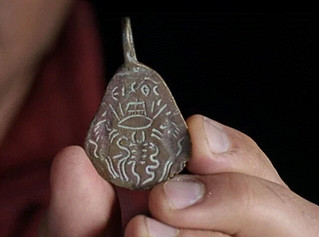 On the amulet's reverse, is an eye pierced by multiple arrows and surrounded by two lions, a snake, a scorpion and a bird.
On the amulet's reverse, is an eye pierced by multiple arrows and surrounded by two lions, a snake, a scorpion and a bird.
Another Greek inscription features on this side and reads: "One God."
According to Dr Eitan Klein, the deputy director of the IAA's Antiquities Theft Prevention Unit, the amulet may have been worn to protect women and children from the influence of the evil eye.
The archaeologist said: "The amulet is part of a group of fifth to sixth-century CE amulets from the Levant that were probably produced in the Galilee and Lebanon.
To read the complete article, see:
Israeli archaeologists unveil 'Solomon's Seal' - an ancient amulet protecting from evil
(https://www.express.co.uk/news/science/1442731/archaeology-news-solomon-seal-amulet-protect-evil-israel-galilee-discovery-evg)
THE BOOK BAZARRE
WAYNE'S NUMISMATIC DIARY MAY 30, 2021
Tuesday, May 18th brought the dinner meeting of my Northern Virginia numismatic social group, Nummis Nova. It was the second in-person dinner we've had since the pandemic lockdowns. First up, Tom Kays provided these images and remarks. -Editor
Nummis Nova has resumed meeting in person. We dined at an old favorite, Southside 815, serving Southern Comfort Food in Alexandria, Virginia, on the third Tuesday in May. Nine hardy souls braved this mask-less
dining experience, tempted by the red beans and rice
on special that night, among other wonderful selections.
The left side of the table seems alarmed, not only that the right side of the table has been served first, but that the right siders
won't wait politely for everyone to be served before digging in.
Right siders
with eyes on the prize, ignore the lefties,
but do bring cutlery to hand, ready for action should butter dish conflict ensue. It has been a long time since we all dined together. Oh, Fugio!
Sorry about the time slip in the pictures. Truly it was wonderful to see each other and get out of the house.
Starting on the left are regulars Mike, Robert, Wayne and Chris, (seen with menus before ordering) and then Steve, (Wayne's guest Pat Parkinson who is a local author of a new book about John S. Dye and his Counterfeit Detectors), Dave, and Jon, all well served a wee bit later. Behind the camera was Tom. Aaron our host did not attend in person but supported us virtually.
In the mood lighting of our fine restaurant, many fascinating objets d'art numismatique passed by, dimly seen but dearly held, and difficult to capture on an iPhone camera; so, I will describe many of them as best I recall. Ask the editor if you want to know more of the story behind these items of distinction. These show and shares
are typical of what is brought to table at Nummis Nova dinners, none are likely to be repeated:
-
A silver medal by R. Lovett of New York with enigmatic legend:
The Personification of Honor, Truth, and Justice.
with reverse inscribedTo J. Fennimore Cooper, The Offering of a Grateful Heart for his Disinterested Vindication of his Brother Sailor Jesse D. Elliott,
- An 1820, Ferdinand VII, Piece-of-Eight from Zacatecas, Mexico with assayer R. G.,
-
A Connecticut Copper (M 48-k.3
Twin Leaf
), - An 1863 copper-nickel, New York Civil War, one cent token by Geo. D. Schmidt, First Avenue Hall, struck over another 1863 token,
- An 1863 copper-nickel, New York Civil War, one cent token by R. T. Kelly, a Hatter, (Top Hat) at 1819 Third Ave., New York, struck over another 1863 token,
- An ancient Phrygian bronze of Antoninus Pius (138 – 161 AD), with Temple reverse (Laodikeia AM Lykos),
- An ancient Ionian bronze of Valerianus I (253 – 260 AD) with Temple reverse,
- A fine selection of the civil rights leader, Congressman John Lewis bronze medals, in memoriam,
-
A distinctive George Floyd bronze medal,
No Justice No Peace
reverse, - A lucky Indian cent encased by an aluminum token of Alexander McCully, Livery, Bus & Transfer of Oswego, Kansas,
- An 18 and 3/4 cent token from the Jones Exchange Hotel (PA-238Ba), circa 1849 – 1850 from the Donald G. Patrick Collection,
- A 1922 Swedish bronze medal of Petter Forsskal, (Explorer of Arabia, born 1782), by Erik Lindberg, issued by the Svenska Akademein, along with ‘the' academy reference book Arans Och Minnets Valuta, Svenska Akademeins Minnespenningar 1786 – 2009.
-
An autographed
Thank You
note to Wayne (Homren) from Kenneth Kipperman, who pictured Alexander Hamilton on the Ten Dollar Bill, - The book Minting, Printing & Counterfeiting During the US Civil War Era by R. Lank and R. Rush,
-
Finally, a fine case of
Island Hopping
Tokens, Guillotines, and Counterstamps:
We leave it as an exercise for the reader to determine which island or island chain is associated with each numismatic item. As an aid to you sleuths, we list all the islands represented alphabetically, (but with a few extra to keep you on your sandy toes):
Azores, Barbados, Bermuda, British West Indies, Cuba, Curacao, Danish West Indies, Dominica, Ireland (The Emerald Isle), Isle de France, Isle of Man, Jamaica, Martinique, Prince Edward Island, Santo Domingo, Tobago, Windward Islands.
I hope your in-person numismatic events begin again and bring you much enjoyment as do these simple dinners. Here's to your health, wealth, and good humor, and to friends far and near, may your pockets embrace old money and your bottles brim with beer.
Thanks, Tom! I wish I'd taken some pictures of my own so everyone could see Tom's magnificent lockdown-grown ZZ Top-style Mountain Man beard. Next up are some of my own exhibits. -Editor
New Books
I brought Pat's John Dye book, but the one passed around the table was his copy. The book provides strong evidence that John S. Dye and conspiracy theorist John Smith Dye were one and the same, answering a query that Pete Smith posed in The E-Sylum in 2001.
I also brought a fresh copy of Minting, Printing & Counterfeiting. Love the title - wish I'd thought that up. See the links below for more information on the books.
To read the earlier E-Sylum articles, see:
JOHN S. DYE AND JOHN SMITH DYE - SAME PERSON?
(https://www.coinbooks.org/esylum_v09n37a07.html)
JOHN S. DYE AND HIS COUNTERFEIT DETECTORS
(https://www.coinbooks.org/v24/esylum_v24n19a07.html)
NEW BOOK: MINTING PRINTING & COUNTERFEITING
(https://www.coinbooks.org/v24/esylum_v24n21a03.html)
BEP Portrait Engraver Ken Kipperman
I have a small collection of notes signed by Bureau of Engraving and Printing portrait engravers. This was signed for me remotely during the pandemic by retired engraver Ken Kipperman.1865 Jewish Orphanage Medal
I also brought along this nice 1865 silver medal from the Netherlands made to celebrate the opening of the Jewish Orphanage. The photo is courtesy Shanna Schmidt who donated it to the American Numismatic Society for their 2021 Gala, where I managed to win it in a raffle. It's a hefty piece and very impressive in person.1865 National Bronze Picture Gallery Portrait Medallions Coincidentally, one topic I brought up at dinner were the two massive 1865 portrait medallions from the National Bronze Picture Gallery by Franklin B. Simmons in the Stacks Bowers June 2021 auction. Lots 1087 (Ulysses S. Grant) and 1088 (Philip H. Sheridan). Note that the online lot descriptions include much more information than the printed catalogs. See an article elsewhere in this issue for more about the National Bronze Picture Gallery.
To read the lot descriptions, see:
1865 Portrait Medallion of Lieutenant General Ulysses S. Grant. By Franklin B. Simmons. Bronze. Choice Extremely Fine.
(https://auctions.stacksbowers.com/lots/view/3-RELU9/1865-portrait-medallion-of-lieutenant-general-ulysses-s-grant-by-franklin-b-simmons-bronze-choice-extremely-fine)
1865 Portrait Medallion of Major General Philip Henry Sheridan. By Franklin B. Simmons. Bronze. Choice Extremely Fine.
(https://auctions.stacksbowers.com/lots/view/3-RELUI/1865-portrait-medallion-of-major-general-philip-henry-sheridan-by-franklin-b-simmons-bronze-choice-extremely-fine)
American Medal of the Year Winners
Jon Radel showed up with the 1st and 2nd place winners in the American Medallic Sculptors Association (AMSA) 2021 American Medal of the Year (AMY) competition.
LEFT: George Floyd, Black Lives Matter by Jeanne Stevens-Sollman
RIGHT: John Lewis by Jim Licaretz
Both great medals. The John Lewis piece is very light, being made from bonded bronze. Powerful portrait.
To read the earlier E-Sylum articles, see:
2021 AMSA MEDAL OF THE YEAR WINNERS
(https://www.coinbooks.org/v24/esylum_v24n16a26.html)
LOOSE CHANGE: MAY 16, 2021 : Judging the Medal of the Year
(https://www.coinbooks.org/v24/esylum_v24n20a34.html)
Tokens Struck Over 1863 Indian Cents Steve Bishop writes:
"Here are images of the two tokens I showed. They are struck over 1863 Indian cents, not tokens."
Boston Eastern Railroad Transportation Tokens Dave Schenkman brought a number of interesting items. Here are a couple rare Boston transportation tokens.
Dave writes:
"The Eastern Railroad issued these tokens during the late 1830s. They are listed in The Atwood-Coffee Catalogue of United States and Canadian Transportation Tokens, as MA 115-C for the check
and MA 115-D for the U P. Check.
This example of 115-D is an unlisted variety, struck from different obverse and reverse dies. The reverse has U. P. CHECK, while the listed token is U P. CHECK."
Oswego, Kansas Alexander McCully Transportation Tokens
Dave writes:
"Alexander McCully owned a livery stable and hack line in Oswego, Kansas. He also was a breeder of purebred horses, and one of them, Rounds' Sprague, became the leading sire in Kansas. Numismatically, McCully has the distinction of issuing two rare and very unusual transportation tokens, one of which promotes his horse business on the reverse. Struck in aluminum, it is 38mm. The other piece is an encased 1904 cent. I know of no other encased cent that was issued used as a fare token."
Philadelphia Jones Exchange Hotel
Dave writes:
"During the 1850s the Jones Exchange Hotel in Philadelphia issued a series of unusual tokens, struck with incuse lettering on brass planchets. I'm attempting to document all known examples, and would be interested in hearing from anyone owning one. I can be contacted at dschenkman@verizon.net."
Kanawha Salt Company $10 Note
Dave writes:
"Although PMG dated the note 1817-19, the Kanawha Salt Company issued this rare note in the 1850s"
Ancient Architecture on Coins
Robert Hoppensteadt exhibited a couple nice ancient coins and provided these descriptions.
LAODIKEIA AM LYKOS. Pseudo-autonomous. AE medallion of 36mm (22.38g). Time of Antoninus Pius, 138 - 161 A.D. coined under Fr. Claudius Attalos, who donated the emission. Ob.: - draped bust of the Gerusia with veil pulled over the back of the head n. r. Rs.: . RPC IV.2, 11599 (temporary) this coin! Martin, Demos II, 241, 1290; Extremely rare, only this example in RPC
Peter Weiss Collection, Kiel, acquired between 1967 and 2015.
P. Claudius Attalos was the son of the famous orator Polemon of Smyrna. Like his father, he was a sophist and a citizen of both Smyrna and Laodikeia.
COLOPHON. Valerian i, 253 - 260 A.D. AE Large Bronze x 32mm (17.58g). Strategos Ael. Pail(...) Kallinikos. V.: - Draped Armored Bust with Laurel Wreath n. r. Rs.: Tetrastyle temple, within which statue of Apollo Klarios seated l.; across field in front of temple, beneath which bull advances r. toward a lighted altar. In foregound, the thirteen cities of the Ionian league, each with hand raised and holding wreath(?)(Klazomenai, Kolophon, Ephesus, Erythrai, Lebedos, Milet, Myous, Phokaia, Priene, Teos, Chios, Samos and Smyrna), Milne, Colophon 263; BMC 60. R!
Image of the assembly of the thirteen cities of the Ionian Coinon in the sanctuary of Apollon Klarios at Kolophon.
Closing Thoughts
Many thanks to everyone for their photos and notes.
It was great to meet Pat Parkinson, a former economist with the Federal Reserve, and of course great to see our regulars in person.
The food was top-notch; I didn't even finish my dessert, and when I got home I felt so full I could do little else but call it a night. A great evening of numismatic fellowship it was. I'm already looking forward to June.
A MEMORABLE CHAIN CENT PURCHASE
Dave Lange submitted this great backstory on a recent coin purchase. Thanks! -Editor
There's usually nothing of general interest to readers in any of my coin purchases, but I recently completed one that may break that rule. We all like coins having cool back stories, and this is about just such a piece.
For the past 20 years I've been rebuilding my USA coin type set that accompanies the class I co-instruct with Frank Van Valen at the ANA's Summer Seminar. My collecting activity has continued without interruption, despite the recent obstacle of the Covid-19 pandemic that precluded this event for the past two years. It's been a real challenge to either match or improve upon the type set I'd built previously during the 1970s-80s that I later sold when my numismatic passion swung to other countries for several years. I don't regret collecting world coins, but I did come to bemoan the sale of many United States coins that later proved hard to replace. Chief among these were my 1793 Chain and Wreath Cents, the values of which soared over the past two decades. These two have now been secured, with the Chain Cent providing a history that's worth relating here.
First, a little background. The example I sold a few years later had been acquired from a Stack's auction of June 19, 1991. I paid $3300 for a piece grading Good with a smooth planchet and nice surfaces. This was a big purchase for me at that time, and it proved to be the final acquisition for my type set that decade. The next 15 years or so were spent in pursuit of nice coins of the United Kingdom and The Philippines under USA sovereignty. These required additional cash, so the dormant USA type set was sold off piecemeal. It was right around the same time that I began to teach a class on United States type coins, first with Ken Bressett and then for years afterward with Frank. We attempted to get by with whatever coins the ANA had in its collection, as well as some loaners from Heritage, but there were simply too many gaps, and the condition of several coins offered little in the way of educational talking points outside of a grading class! That's when I again changed direction and began chasing United States type coins in higher grades than had been the case with my first set. Only the toughest ones are left now, so some difficult decisions have to be made.
I was on the fence about whether I'd be able to add the Chain and Wreath Cents, but the coins just seemed to find me. The Wreath Cent, though Details graded, is a pleasing piece with enough meat left on it to serve its purpose. Chain Cents are quite costly, even when not numerically graded, and I was concerned that nothing desirable would be possible within a reasonable budget. After some negotiating, however, I struck a deal for an attractive coin certified as VF DETAILS, ENVIRONMENTAL DAMAGE. The term "environmental damage" is sometimes applied to coins that have very little eye appeal, but it's used as well for those which are within microns of being numerically gradable, and I succeeded in securing one of the latter.
After our negotiations were completed and the purchase made, the seller told me the back story on this coin and how he came to own it. This Chain Cent, an example of Sheldon-3, was found in 1980 within the door frame of a house built around 1795 in Lancaster, Pennsylvania. The Amish family which discovered it brought the coin to [Dennis] Steinmetz Coins and Currency, Inc., a prominent dealership in that city, which took the cent on consignment. Shortly afterward, the father of the person from whom I purchased it came into the store looking to sell some 20,000+ Buffalo Nickels. Having a casual interest in large cents, he asked whether anything new or interesting was available, and he was shown the Chain Cent. Well, instead of leaving with spending cash from his nickel hoard, he found himself putting up supplemental money to purchase the rare coin. From him it later passed to the most recent owner, whose own son made it clear that he was not a coin collector. Thus, it was time to sell, and now I have this lovely cent, and it will be shared with my students when Summer Seminar returns.
Nice coin - quite respectable. Congrats on your purchases, and good luck with your quest to reassemble your type set. -Editor
THE U.S. MINT AND THE MANHATTAN PROJECT
The MPC Gram is a newsletter for collectors of Military Payment Certificates and other military numismatica. The 29 May 2021 issue includes a fascinating short article by Bill Myers about the connection of the U.S. Mint to, believe it or not, the Manhattan Project. Republished with permission. Thank you! This is noted anywhere else in numismatic literature including The Numismatist, Coin World, various periodicals, and earlier E-Sylum articles. -Editor
MANHATTAN PROJECT
by Bill Myers
 At the 2021 MPC E-FEST my presentation was about coins melted for war materiel during World War II. It was brought up that I did not include the fact that the United States as the US Mint provided silver for the Manhattan Project. The Manhattan Project needed enriched uranium for the atomic bomb. The United States built Plant Y-12 in Oak Ridge, TN. It used electromagnets to separate U-235 (weapons grade) from U-238. The coils of magnets are usually made of copper but copper was critical for the manufacture of war materiel so it was not available. Silver has an electroconductivity that is similar to copper. 14,700 tons of silver were borrowed from the US mint to make the coils.
At the 2021 MPC E-FEST my presentation was about coins melted for war materiel during World War II. It was brought up that I did not include the fact that the United States as the US Mint provided silver for the Manhattan Project. The Manhattan Project needed enriched uranium for the atomic bomb. The United States built Plant Y-12 in Oak Ridge, TN. It used electromagnets to separate U-235 (weapons grade) from U-238. The coils of magnets are usually made of copper but copper was critical for the manufacture of war materiel so it was not available. Silver has an electroconductivity that is similar to copper. 14,700 tons of silver were borrowed from the US mint to make the coils.
The silver was returned to the US Mint on 1 June 1970 with a loss of 36/1000 of 1%. The silver was from bullion stores and coins were not melted to produce the atomic bomb, even though stated in older references. No coins were harmed in the making of the atomic bomb.
For more information, see:
The Manhattan Project
(https://www.atomicheritage.org/history/manhattan-project)
To subscribe to MPC Gram, click here .
To read earlier E-Sylum articles, see:
ATOMIC NUMISMATICS
(https://www.coinbooks.org/esylum_v06n23a21.html)
SILVER COINS AND THE MANHATTAN PROJECT
(https://www.coinbooks.org/esylum_v10n21a30.html)
THE FAROUK 1933 DOUBLE EAGLE, PART 2
With permission, here's an excerpt from the very detailed history description of the Farouk 1933 Double Eagle up for auction in Sotheby's June New York sale. Thanks. -Editor
THE BRIEF LIFE AND DEATH OF AMERICA'S LAST GOLD COIN
The Factory on Spring Garden Street
As citizens lined up to return their gold at Federal reserve banks, the employees within the massive neoclassical edifice of the Philadelphia Mint saw little action. Both the Cashier's and Coining Departments' daily records reflect this torpor. In that beleaguered, depressed economy there was little need to make new money; the entire 1933 production at the Philadelphia Mint approximated a single day's output in 1928.
Each step of production and delivery was carefully choreographed and scrupulously recorded. On Thursday, March 2, the first 1933 Double Eagles were struck, but it was not until March 15, 1933 that the requisite number (25,000) passed quality control when the first delivery to the Cashier was made.
The delivery from coiner to cashier, as responsibility passed from one entity of the mint to another, was memorialized in manifold ways on multiple documents. Two examples were sent to Washington, D.C., for Special Assay to ensure quality, and an additional one coin from every thousand delivered was sealed in an envelope and deposited in a double-locked wooden box which would be opened at the Annual Assay the following February. At the close of March 15, the Cashier recorded in his Daily Settlement the remaining number of 1933 Double Eagles in his custody: $495,000 in the basement vault, and $4,460 (223 pieces) in an office safe. The gross amount received, less those reserved for assay, was recorded on the official Cashier's Daily Statement and sent to Mint headquarters. A total of ten deliveries (445,500 pieces), similarly recorded, were made, the last on May 19; in June the vast majority of 1933 Double Eagles was placed in Cage 1 of the massive Vault F—dead storage.
On January 30, 1934, with the government's vaults replenished by hundreds of millions of dollars in recalled gold, the Gold Reserve Act of 1934 was passed and abolished gold as a component of the monetary system.
Two weeks later, the last gold coins ever struck for circulation by the United States, the 1933 Double Eagles, were tested by the Annual Assay Commission. This newsworthy event marked the last testing of gold coins and the first Assay Commission presided over by a woman, Nellie Tayloe Ross.14 Nine Double Eagles were destroyed, and the remainder were noted by the cashier as received on February 20, 1934.
In August 1934, Mint Director Ross ordered the melting of all gold coins held by the government—the 1933 Double Eagles awaited destruction. In October, she ordered that two examples be sent to the Smithsonian, the only institution or private collection that would ever be permitted to own an example of these historic coins — legally. But not the only one that wanted one.
TO HAVE NOT– AND HAVE
It is susceptible to no waiver . . .
JUNE 1934 LETTER FROM PHILADELPHIA COIN DEALER HENRY CHAPMAN TO CONNECTICUT STATE LIBRARIAN GEORGE GODARD, INDICATING HE HAD BEEN UNABLE TO GET 1933 DOUBLE EAGLES IN 1933. (CREDIT: CONNECTICUT STATE LIBRARY ARCHIVES)
In 1911 the State of Connecticut was bequeathed a stellar collection of coins, with the stipulation that examples of current United States coins be added annually. This responsibility fell to State Librarian George Godard, whose requests to the Mint and Treasurer's Office were honored for two decades. But not in 1933.
Connecticut's initial request for examples of 1933 Double Eagles was rejected, and on August 14 an appeal was subsequently turned down by Assistant Secretary of the Treasury Thomas Hewes, who wrote: The prohibition is susceptible to no waiver.
In July 1934, Godard determinedly contacted coin dealer Henry Chapman to see if he could supply the 1933 gold coin coinage.
Renowned for his close ties to the Philadelphia Mint, Chapman, though old and frail, responded: I cannot supply your want. Just about a year ago a collector came in and said he had tried to get a $20 gold piece for his collection but the government had denied him and he asked us to try and see what we could do. They refused.
No gold coins may be supplied . . .
Similarly, the American Numismatic Society regularly purchased new coinage for its collection. Its relationship to the Mint and Treasury Department could not have been closer: Treasury Secretary Woodin, a learned coin collector, was a Board member; when in 1932 the ANS curator Howland Wood wrote to the Mint complaining about the quality of a Double Eagle just purchased, the mint director personally selected its replacement; and in January 1934, as new laws concerning gold coin ownership were being written, the ANS helped officials craft the language. But when the Society tried to obtain a 1933 Double Eagle it failed—repeatedly.
The correspondence, beginning April 28, 1933, includes a direct appeal to the Treasury Secretary from his friend ANS President Edward Newell, asking him to put the wheels in motion so we can order these.
Letters from Wood to his longtime correspondent Assistant Mint Director Mary O'Reilly were met with pro forma responses. And finally, an offer from the ANS to exchange a Double Eagle
of another date met with the constant refrain of: no gold coins may be supplied.
If it is not against the law . . .
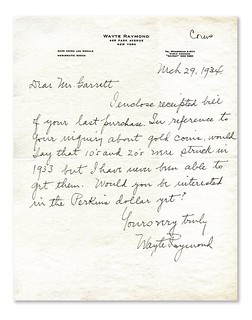 On February 2, 1934, former Ambassador John Work Garrett, owner of one of the greatest coin collections ever formed in America, thought it
On February 2, 1934, former Ambassador John Work Garrett, owner of one of the greatest coin collections ever formed in America, thought it might be interesting
to add to his collection if it is not against the law, the last gold pieces.
His inquiry was sent to Wayte Raymond, one of the nation's leading coin dealers, whose reply was blunt: I have never been able to get them.
No one who tried to legally acquire a 1933 Double Eagle from the government could — ever.
More next week. Meanwhile, give a listen to the CoinWeek podcast with David Tripp. -Editor
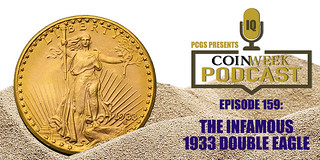 This week on the CoinWeek Podcast, numismatic researcher and author David Tripp joins us to talk about the 1933 Double Eagle. You know that the 1933 Saint-Gaudens Double Eagle is the most notorious coin in the U.S. series, but do you really know the coin that the FBI spent more than 60 years pursuing? We talk to David about the one example of this notorious coin that the government couldn't keep.
This week on the CoinWeek Podcast, numismatic researcher and author David Tripp joins us to talk about the 1933 Double Eagle. You know that the 1933 Saint-Gaudens Double Eagle is the most notorious coin in the U.S. series, but do you really know the coin that the FBI spent more than 60 years pursuing? We talk to David about the one example of this notorious coin that the government couldn't keep.
To listen to the podcast, see:
CoinWeek Podcast #159: The Infamous 1933 Double Eagle (with David Tripp)
(https://coinweek.com/coinweek-podcast/coinweek-podcast-159-the-infamous-1933-double-eagle-with-david-tripp/)
To read the complete lot description, see:
The 1933 Double Eagle
(https://www.sothebys.com/en/buy/auction/2021/three-treasures-collected-by-stuart-weitzman/the-1933-double-eagle)
To read the earlier E-Sylum article, see:
THE FAROUK 1933 DOUBLE EAGLE
(https://www.coinbooks.org/v24/esylum_v24n21a24.html)
THE AUCTION OF A PURPLE HEART
Gerry Tebben writes:
"There were two stories in the Wall Street Journal this week that bear on the hobby: One, curiously about Bitcoin and banking before the Civil War and one about the the auction of a Purple Heart. The story is a moving Memorial Day piece on a Marine's effort to return a posthumously awarded Purple Heart to the family. I don't collect military medals, but always and wrongly thought it was illegal to sell them. Auctioneer Bill Panagopulos of Alexander Historical Auctions features prominently in the article, explaining the business of buying and selling historical artifacts. I won't spoil the story for you (It's well worth the read.) but the business part of it should be familiar to everyone in the hobby."
Thanks. I'd seen these stories as well. The cryptocurrency one appears later in this issue. Here's an excerpt of the Purple Heart piece. -Editor
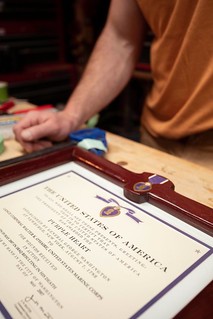 A career in the military is laid out in those medals and ribbons, which can be read like a résumé. Mine show that I've been to Iraq and Afghanistan, that I was awarded a couple of personal-achievement awards, that I saw combat but was never wounded. Even now, when I look at them, that distilled summary of years in uniform, I'm taken back to the places where they were earned and remember the people who were there.
A career in the military is laid out in those medals and ribbons, which can be read like a résumé. Mine show that I've been to Iraq and Afghanistan, that I was awarded a couple of personal-achievement awards, that I saw combat but was never wounded. Even now, when I look at them, that distilled summary of years in uniform, I'm taken back to the places where they were earned and remember the people who were there.
Certain medals, like the Purple Heart, stand out like talismans.
I thought of Gator every so often when passing by a memorial roster somewhere in the nation's capital, scrolling over the lists of war dead posted in a House of Representatives hallway, maybe. But mostly, all that was in the past.
Early this February, I received a message from Charlie Williams, who was a lance corporal on that Golf Company deployment. He had gotten wind that Gator's posthumous Purple Heart certificate, his medals and what was described as the flag that adorned his casket were all for sale through an online auction site called Alexander Historical Auctions.
This strikes me as the kind of thing that's legal, but crummy,
he said in an email.
The items had gone missing years ago, through a series of family misfortunes. For years, Gator's mother, Maureen O'Haire, struggled with finances and threats of eviction. Her house caught fire in 2015, destroying nearly everything. The family saved the few things they could, including the urn containing her husband's ashes.
A firefighter who had served with Gator in Fallujah showed up to that blaze, knew where the medals were, and ensured they were recovered.
Maureen died soon after, in 2016, and many of her possessions ended up in a storage unit. In the aftermath of the house fire and then Maureen's death, Gator's siblings never found out what happened to the medals. There seemed to have been a lapse in paying the storage fee, but nobody knew for sure.
His family certainly didn't want them sold and didn't know who was selling them.
The online auction clock was already ticking away when I clicked on the website. The bidding had gotten to a few hundred dollars, inexpensive enough for Gator's friends to come up with, but there were still days left in the bidding. Who knew how high the price might go?
The oldest award
The Purple Heart is the country's oldest military award, first given by Gen. George Washington to troops during the Revolutionary War as a Badge of Military Merit.
The modern version, whose criteria were established in 1932, is awarded to troops wounded in combat. For those who make the ultimate sacrifice, it is presented posthumously to the surviving family.
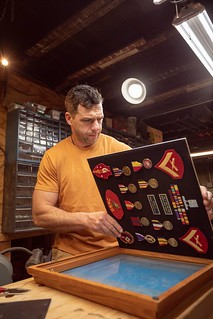 There's a federal law prohibiting the sale of the Medal of Honor, the nation's highest award for military heroism. But no such law exists for other military medals. That means anyone at a pawnshop, antique mall, swap meet or online auction house is free to buy, sell and trade the memorabilia.
There's a federal law prohibiting the sale of the Medal of Honor, the nation's highest award for military heroism. But no such law exists for other military medals. That means anyone at a pawnshop, antique mall, swap meet or online auction house is free to buy, sell and trade the memorabilia.
For collectors, the Purple Heart has become a bauble that can fetch a premium. Some medals are awarded to troops for doing little more than signing up to join the military. But the Purple Heart requires sacrifice and is recognizable to many Americans. It brings the aura of war to the den of any armchair warrior.
The monetary cost of the medal is a bargain compared with what was paid by the person who earned it. Those presented posthumously, and which can have the deceased's name engraved on them, are especially tempting to collectors because they are a one-of-a-kind representation of pain, loss and heroism.
I've argued against making the sale of any medals illegal. I understand the reasoning and emotions involved, yet the reality is that the marketplace is often what saves these treasures from the trash bin and enables their eventual return. The auctioneer Bill Panagopulos explained it well. -Editor
In true Panagopulian fashion, the voluble auctioneer took two hours, three bourbons, dozens of profanities and at least one cigar to explain his mindset over the phone.
He told me that it saddens him every time a set of medals comes up for auction because it means that the service member no longer has anyone to care for his or her legacy. Oftentimes, some distant relative finds the stuff in an attic and gets rid of them, sometimes a descendant just needs some pocket money. He's seen it so many times that he figured that was the case with Gator's memorabilia.
I said what the hell kind of family would give this up?
he told me. I didn't feel comfortable offering it for sale but that's my job.
And, he added, the collectors he's worked with for decades aren't disrespecting the memory of deceased warriors, on the contrary, they're honoring them.
Collectors often buy Purple Hearts and meticulously research the deceased in the National Archives. They display the medals in a place of prominence.
They become the new family, and you can quote me on that,
Mr. Panagopulos said. They live vicariously through it. They feel like they're standing next to the guy when he threw that grenade into that pillbox.
When a family abdicates taking care of a service member's legacy, Mr. Panagopulos feels it's his job to make sure his memorabilia ends up in a place of reverence. Why not in the hands of a dedicated and sympathetic collector?
The medals were eventually reunited with the family. It's a great story, well worth reading all the way through. -Editor
To read the complete article (subscription required), see:
I Thought I Was Done With Iraq. Then a Fellow Marine's Purple Heart Turned Up at Auction.
(https://www.wsj.com/articles/one-last-mission-return-a-fallen-marines-purple-heart-to-his-family-11622203330)
THE NATIONAL BRONZE PICTURE GALLERY
As noted in this week's Numismatic Diary, here is some more information on the National Bronze Picture Gallery from the Stacks Bowers June 2021 auction. -Editor
This series of substantial bronze portraits was conceived by William H. Miller, owner of William H. Miller & Sons Foundry, in Providence, Rhode Island. In 1864, as the Civil War raged, Miller commissioned Maine sculptor, Franklin B. Simmons to produce a series of bronze portrait reliefs featuring Abraham Lincoln, his cabinet, and significant Union generals. Simmons moved to Washington D.C. to work on the project, reportedly drawing from life all or most of the distinguished persons he would eventually fashion into bronze. Most accounts suggest the series was 24 portraits, though the Union League of Philadelphia website gives the number as 31. The complete series was finished in 1865, and was titled the National Bronze Picture Gallery. Again according to the Union League, the series of portraits was "exhibited in several northern cities including New York City, Chicago and Philadelphia, where the medallions were displayed at the 'Great Fair in Honor of the Soldiers and Sailors Home' held at the Academy of Music between October 23 and November 4, 1865." The two pieces offered here are from this impressive series, and make clear that Simmons' skill was substantial. As per the marks on these pieces, the castings themselves were almost certainly done at the Miller foundry.
Franklin B. Simmons was an accomplished sculptor of portraits and life-size figures, born in 1839 near Lewiston, Maine where he grew up. He studied painting for a short time under John Bradley Hudson, Jr., but later shifted his focus to sculpture, which he found much more to his liking. He expanded his skill in sculpture under the tutelage of John Adams Jackson, in Boston, before returning to Lewiston, where he opened his first studio. While in Washington for the work on this series, Simmons sculpted a marble bust of William Tecumseh Sherman, now in the collection of the San Francisco Museum of Art. After completing his work in Washington, Simmons returned to Maine where he accomplished the first life-size portrait statue in the state, that of Union Major General and son of Maine, Hiram Berry, who had been killed in battle at Chancellorsville. He was commissioned by the state of Rhode Island to create another life-size figure, that of Providence Plantations founder, Roger Williams, which is displayed in the United States Capitol's Statuary Hall.
Having taken an interest in classical sculpture, he relocated to Rome in 1868, where he largely lived out the rest of his life, with occasional return trips to the United States. He died there in 1913. Many of the bronzes from the National Bronze Picture Gallery are owned by the Union League of Philadelphia, to which they were donated or sold (accounts vary) in the 1860s by William H. Miller. Other works by him are in the Portland Museum of Art, United States Naval Academy, Washington Memorial Chapel at Valley Forge, Museum of Fine Arts, Boston, Metropolitan Museum of Art, and other institutions. Several works, in addition to the Roger Williams marble, can be found at the United States Capitol Complex.
The works of the National Bronze Picture Gallery owned by the Union League of Philadelphia are as follows: Abraham Lincoln, Salmon P. Chase, William H. Seward, Christopher C. Augur, Nathanial P. Banks, Ambrose Burnside, Benjamin F. Butler, Abner Doubleday, Ulysses S. Grant; Winfield S. Hancock; Joseph Hooker, George Gordon Meade, Alexander S. Webb, Horatio Gouverneur Wright and John Grubb Parke.
To read the lot descriptions, see:
1865 Portrait Medallion of Lieutenant General Ulysses S. Grant. By Franklin B. Simmons. Bronze. Choice Extremely Fine.
(https://auctions.stacksbowers.com/lots/view/3-RELU9/1865-portrait-medallion-of-lieutenant-general-ulysses-s-grant-by-franklin-b-simmons-bronze-choice-extremely-fine)
1865 Portrait Medallion of Major General Philip Henry Sheridan. By Franklin B. Simmons. Bronze. Choice Extremely Fine.
(https://auctions.stacksbowers.com/lots/view/3-RELUI/1865-portrait-medallion-of-major-general-philip-henry-sheridan-by-franklin-b-simmons-bronze-choice-extremely-fine)
Here are some other medallions owned by the Union League of Philadelphia. -Editor
The above photos are Courtesy of The Union League Legacy Foundation. Thank you! I also reached out to medal specialist Scott Miller, who provided these additional comments and links. Thanks! -Editor
I am not aware of any write-up on these medals, but have no doubt it exists somewhere, possibly in the third annual report of the Union League of Philadelphia. Here are links for a few things that might be of interest.
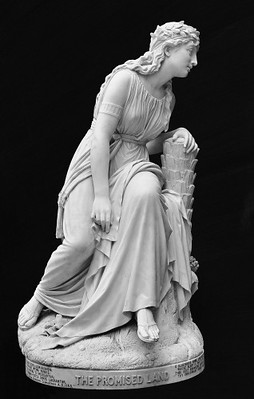 There was an article on the sculptor, Franklin Simmons in The International Studio in 1905, vol. 25
There is no mention of the plaques, but other work is shown.
https://babel.hathitrust.org/cgi/pt?id=hvd.32044039107198&view=1up&seq=350
There was an article on the sculptor, Franklin Simmons in The International Studio in 1905, vol. 25
There is no mention of the plaques, but other work is shown.
https://babel.hathitrust.org/cgi/pt?id=hvd.32044039107198&view=1up&seq=350
A few other links
https://www.spellmangallery.com/artists/franklin-w-simmons
This consists of two volumes, and they are fantastic. It has a brief mention of the plaques.
There are several works by Simmons, including two plaques, in the collection of the Bowdoin College Museum of Art.
https://artmuseum.bowdoin.edu/objects-1/thumbnails?records=40&query=mfs%20all%20%22franklin%20simmons%22&sort=0
For more information, see:
Large medallion with relief of William Henry Seward profile in wooden frame
(https://ulheritagecenter.pastperfectonline.com/webobject/C269FCE4-9980-4C3A-9BE2-857487915465)
Large medallion with relief of Abner Doubleday profile in wooden frame.
(https://ulheritagecenter.pastperfectonline.com/webobject/30FACF0E-4F90-4757-BED0-449368301343)
https://www.unionleague.org/
THE CASHIER WHO TOOK GEORGE FLOYD'S $20 BILL
On the first anniversary of the event that thrust him into the news, The Guardian interviewed the cashier who took George Floyd's $20 bill. -Editor
 Christopher Martin lived above a bricked grocery store in south Minneapolis, with a maroon awning and bold red signage that reads Cup Foods. So when a cashier's position came up last year, he took it without thinking.
Christopher Martin lived above a bricked grocery store in south Minneapolis, with a maroon awning and bold red signage that reads Cup Foods. So when a cashier's position came up last year, he took it without thinking.
He quickly learned the regulars' orders by heart, their specific tobacco preferences, their favored snacks. The job was more than just a paycheck. A family, community base,
he remembered. A lot of jokes and laughs.
But on 25 May last year, he served a customer he had never met before, igniting a chain of events that rippled around the world and irreversibly changed Martin's life.
It was George Floyd, who had come to Cup Foods that day to buy a packet of cigarettes. He handed Martin an allegedly counterfeit $20 bill. Martin accepted, and then informed his managers. A co-worker called the police. And shortly after, George Floyd would be dead, held for nine minutes and 29 seconds under a white police officer's knee as Martin watched from the sidewalk in disbelief.
Within a week he and his family moved from their apartment. He quit his job. He battled with grief and trauma. And eventually he testified as an eyewitness in Chauvin's murder trial – one of the most closely watched and significant cases in modern American history.
Martin testified on the third day of the trial. He was one of seven bystanders to take the stand, a choice he made to tell the whole world what really happened that day
.
Dressed in a black and grey windbreaker, he told the jury calmly how he had considered putting the counterfeit $20 on his own tab, but had been told by store managers instead to confront Floyd before the police had been called.
Hours after the guilty verdicts against Chauvin were delivered, Martin returned to Cup Foods and stood at the site where Floyd took his last breath.
Miss you brother,
he posted on Instagram below a picture of himself looking up at a giant mural of Floyd painted next to the store.
I'm still quite curious to learn what happened to that bill in the aftermath of the event. Whether it was actually counterfeit is moot at this point, but it's one of the most famous (or infamous) banknotes since the Lindbergh kidnapping or the hijacker "D. B. Cooper". -Editor
To read the complete article, see:
‘I allowed myself to feel guilty for a very long time': the teenage cashier who took George Floyd's $20 bill
(https://www.theguardian.com/us-news/2021/may/23/christopher-martin-george-floyd-minneapolis-cup-foods)
A local TV station interviewed a U.S. Secret Service agent from the Minneapolis Field Office about counterfeit currency. -Editor
The Minneapolis Field Office investigates counterfeit money. The special agent in charge says they catch more than a million dollars in counterfeit bills in Minnesota each year. SAC Joe Scargill explains where it comes from, and how you can spot it.
Money passes hands every day at stores and for services. Scargill says counterfeit money does too.
Oh absolutely, absolutely, yeah,
Scargill said. Most of what we see here in the Twin Cities area is made locally, which means it's produced in someone's house, in someone's car, in someone's basement.
To read the complete article, see:
Where Counterfeit Money Comes From, And How To Spot It
(https://minnesota.cbslocal.com/2021/05/26/where-counterfeit-money-comes-from-and-how-to-spot-it/)
WALL STREET'S CRYPTO ARTIST
Money artist J.S.G. Boggs would certainly appreciate the work of "Wall Street's Crypto Artist" Sarah Meyohas. Here's an excerpt from Tuesday's Wall Street Journal. -Editor
 Sarah Meyohas's work at the intersection of art, technology and finance earned the contemporary artist fame with financiers and tech geeks. Her latest piece aims squarely at the crypto crowd.
Sarah Meyohas's work at the intersection of art, technology and finance earned the contemporary artist fame with financiers and tech geeks. Her latest piece aims squarely at the crypto crowd.
Long before Beeple's digital collage fetched tens of millions of dollars at auction, Ms. Meyohas was experimenting with using the blockchain technology behind bitcoin to make art. The result looked a lot like the so-called nonfungible tokens that have powered millions in art sales in recent months, along with NBA Top Shot and other digital collectibles. NFTs are similar to bitcoin: Each one is unique, allowing them to act like deeds proving ownership of digital assets.
Ms. Meyohas's work places her at the vanguard of this art-world revolution. She will be relaunching an early project, Bitchcoin, on the Ethereum network, with a public presale at Phillips auction house on May 25. Her 2015 project sold tokens entitling investors to portions of her photographic prints. The new Bitchcoins will be backed by flower petals from a previous work called Cloud of Petals.
Big artists are like central banks, you control the supply, you have to show it at museums, it has to be appreciated culturally, and you create a market for your work,
said Ms. Meyohas in a recent interview. The extreme of this is the artist becomes the currency.
Ms. Meyohas said she doesn't view buying an NFT as purchasing art in the traditional sense. The transparency of pricing makes her queasy, along with the encouragement of speculation, which happens at hyperspeed compared with the normal art world. Additionally, many of the artists who have been doing well financially tend to release drops
of hundreds of the same image.
It's freely available information,
she said. It's a way to attach your identity and a stronger claim on this art than a like. NFT are social interactions.
Bitchcoin functioned as a sort of proto-NFT, and the boom in digital tokens has brought a niche of tech-focused artists into the mainstream. Some use blockchain technology to find new buyers, or to authenticate digital works, which are easily replicated. Others use it in their art itself, raising questions about art's relationship to ideas of value.
That continues a tradition from Marcel Duchamp's Monte Carlo Bonds
—sold to raise money to finance a system of winning at roulette—to J.S.G. Boggs, known for trying to spend his hand-drawn bank notes.
Art is authorized by the artist; paper money is authorized by the bank,
said David Joselit, an art historian and professor at Harvard University. Currency is a form of representation and has always been very close to the kind of representations of value art implicitly has.
Ms. Meyohas began exploring those concepts as a student at Yale University's master of fine arts program, when she learned about bitcoin and decided to use blockchain, which acts as a digital ledger storing information, to explore systems of value.
Bitchcoin was a play on bitcoin and a commentary on the financialization of the art world. They sold for $100, and buyers with 25 coins could trade them for one of her prints, even ones not yet produced. The opening party was held at Trinity Place, a restaurant inside a turn-of-the-century Wall Street bank vault commissioned by Andrew Carnegie.
Her 2016 Stock Performance
earned Ms. Meyohas attention from Wall Street. In that work, she day-traded from Manhattan's 303 Gallery, attempting to shift the share prices of various small, thinly traded companies. Then she painted the resulting stock charts. The paintings sold for $10,000, and the residency earned nationwide media coverage, with fans including Bloomberg financial columnist Matt Levine.
To read the complete article (subscription required), see:
Meet Wall Street's Crypto Artist
(https://www.wsj.com/articles/meet-wall-streets-crypto-artist-11621675805)
To read earlier E-Sylum articles see:
MARCEL DUCHAMP'S MONTE CARLO BOND NO 1
(https://www.coinbooks.org/esylum_v14n05a20.html)
J.S.G. BOGGS (1955-2017)
(https://www.coinbooks.org/v20/esylum_v20n05a04.html)
STABLECOINS AND THE WILD WEST OF FINANCE
Gerry Tebben passed along this Wall Street Journal article about Bitcoin and banking before the Civil War. Thanks! Here's Gerry's comment. and an excerpt from the article. -Editor
Gerry writes:
"I don't understand cyber currencies. I don't even understand the possibility of understanding them. They seem more theology than economics to me. But there is something called a Stablecoin that tries to bridge the unfathomable gap between the etherial currencies and greenbacks. The article tries to explain it. I understand antebellum banking, but don't understand why anyone would want to go back to it."
Stablecoins are one of the weirdest things in the whole bizarro world of cryptocurrencies, because they operate on principles directly opposed to the rest of the crypto system.
Stablecoins are a type of cryptocurrency tied one-for-one to dollars or other traditional currencies and whose value relies on trusting the issuer.
Stablecoins have also become central to the financial infrastructure of crypto. According to data provider Crypto Compare there's more trading between Tether and bitcoin than between bitcoin and all fiat currencies put together. For crypto traders, at least, stablecoins are a vital tool, because of the speed with which they can be used to move money from one crypto exchange to another, and because they provide a handy way to park cash temporarily in what is basically dollars.
This creates a major vulnerability for crypto. Instead of building a new financial system immune to the problems of the old one, it is reinventing problems long-since mitigated by regulators in traditional finance.
To understand this weakness, a quick history lesson. Stablecoins are the living embodiment of free banking, the system of lightly-regulated and often fraudulent issuers of dollar bank notes that dominated U.S. finance until the government stepped in after the Civil War. Paper money was backed by the assets of these banks. But trust in those assets determined whether and how big a discount to apply to any given dollar bill. Alongside the regulated banks were thousands of issuers of small-value IOUs, such as from a Michigan barber, that were used as money in frontier towns short of cash.
There's a good reason these stablecoins of yore were eventually junked. Users of money—that is, pretty much everyone—had to keep up-to-date on the condition, and perceived condition, of dozens of bank note issuers to avoid being duped on a transaction. The costs of this alone were incalculable, quite aside from the widespread failures and fraud.
The twin dangers to the scores of stablecoins that have been created are the same as the pre-Civil War scrip: the assets turn out to be worth less than thought, or people come to believe that the assets are worth less than thought and there's a run.
The biggest stablecoins—from Tether, Circle and Paxos—publish reports from accountants attesting that their assets match the amount issued, in an attempt to ensure trust. So far, all three have succeeded, with their stablecoins proving remarkably stable around $1.
A glance at the free banking era should remind traders of the risks. Back in the 1830s, banks would fool auditors by shipping the same chest of coins from one to the next to be counted multiple times, or by topping up a barrel of nails with a layer of silver, according to Joshua Greenberg's enjoyable study of the era, Bank Notes and Shinplasters.
The parallel is clear from the details of Tether's $18.5 million settlement with the New York Attorney General in February. It said Tether was lying about having full backing for its issues, and when Tether tried to head off rumors about its financial situation by employing an accountant to attest to the assets, cash was put into its new account only on the day of the assessment. Tether also lent $475 million to work with Bitfinex to help it through a cash crunch, this time the day after publishing the balance of a new bank account in the Bahamas. This is the modern version of mobile chests of silver.
It surprises me that Tether is so popular given the revelations from the New York case, the ease with which it can suspend payments and the concern among regulators, including the Fed, about stablecoins. But there is a key difference to the earlier era that helps stablecoins avoid the discounts that plagued the bank notes of the Wild West.
Back then the effort of traveling to a bank's branch to swap its notes for solid silver dollars meant it was hard to arbitrage away discounts, especially for notes from faraway banks. In the digital world it isn't much of a hassle to cash in a stablecoin, so any discount quickly vanishes.
At least so long as the stablecoin issuer has ready money to pay back claims.
To read the complete article (subscription required), see:
Bitcoin's Reliance on Stablecoins Harks Back to the Wild West of Finance
(https://www.wsj.com/articles/bitcoins-reliance-on-stablecoins-harks-back-to-the-wild-west-of-finance-11622115246)
THE BOOK BAZARRE
CAN I PAY THE TAXMAN IN COMMEMORATIVE COINS?
Dick Hanscom passed along this Daily Mail article about the quandary of spending "legal tender" commemorative coins. -Editor
Back in 2015, I bought some commemorative Winston Churchill £20 and Buckingham Palace £100 coins from the Royal Mint, thinking that they were legal tender so the value could only ever increase.
That might be technically true, but that's only as good as my ability to actually spend or deposit them.
I've tried depositing them at a couple of banks, but they've all refused. I've tried paying Vehicle Excise Duty with them at the Post Office, but they also refused payment.
I've heard some reports of people spending £20 coins by filling up with fuel, but I can't get up to £100 to spend those coins given the size of my car's fuel tank, and I'm not very keen on making myself unwelcome at the fuel station.
I have a hefty HMRC tax bill coming up for the 2020-21 tax year, and it feels like I ought to be able to pay off some of that with these coins, but I can't work out any way to actually pay HMRC in cash.
At this point, I'm sort of resigned to just selling the coins on eBay, for probably less than their face value. Does anyone have any more cunning ideas? – via Reddit
George Nixon, This is Money, replies: At This is Money, our award-winning coin coverage tends to focus on loose change which actually enters into circulation.
Largely, this is because they can't simply be bought and therefore have added value based on their scarcity and the essential 'luck of the draw' of getting them.
But there is another kind of coin you do buy deliberately and has a monetary value on it: the commemorative coin.
However, five years ago we also broke the news the Mint had launched a crackdown on the acceptance of special, high-value commemorative coins advertised as 'legal tender'.
As we reported, the Mint told banks in a letter that commemorative '£20, £50 and £100 coins are issued for commemorative purposes only and are not intended to be used as cash.
'Members should not accept the coins at bank branches and customers who wish to return the coins should be referred to the Royal Mint.'
This came as we reported on how one of our readers, James, had an air mile-earning wheeze come unstuck, which left him with £29,000 worth of commemorative coins that HSBC wouldn't let him cash.
He had been buying them on a points-earning credit card - to rack up rewards - cashing in the coins and then paying off the balance, before the scheme was brought to an abrupt end.
The confusion largely stems from the central issue of 'legal tender', which many people tend to equate with 'able to be accepted in shops'. This is not the case.
'In practice this means that although the silver UK coins we produce in denominations of £5, £20, £50 and £100 are approved as legal tender, they have been designed as limited edition collectables or gifts and will not be entering general circulation. As such, UK shops and banks are unlikely to accept them.'
Currently, the Mint offers a £5 coin commemorating the English king Alfred the Great, which it is selling for £13.
While it is legal tender, this does not mean that it can be put in your wallet, taken into a shop and used to pay for anything, and banks will not take them over the counter.
According to Phil Mussell, from Coin News magazine, which works with the Mint, the issue with this reportedly dates back to 1990. At that point, commemorative British crowns released to celebrate the Queen Mother's 90th birthday changed from having a value of 25p to one of £5.
Banks began 'getting jittery about this', Phil said, and even though the Mint issued no guidance about this at the time, it subsequently got 'fed up of having these £5 coins sent back to them'.
After all, he added, 'the Royal Mint is a private company, it's in the business of selling coins not buying them back.'
The same situation applies to uncirculated commemorative 50p, £1 and £2 coins, as well as higher-value pieces which have no circulating equivalent.
But all is not lost for the Reddit user. -Editor
But Phil believes you have missed a trick.
Although you state: 'I'm sort of resigned to just selling the coins on eBay, for probably less than their face value, so significantly less once eBay fees have been taken into account', that might not be the case.
He said: 'You'd be a fool to cash them in for £100. The vast majority of these coins are worth more than their face value, largely as many of them are made of gold.'
The £20, which you said was a 2015 silver coin featuring Winston Churchill, was issued just 200,000 times, according to Chards.
For comparison's sake, that is scarcer than the rarest circulating 50p around, the 2009 Kew Gardens coin, which can sell for over £100 at times. More recently, five Alfred the Great £5 coins have sold for £14.50, according to eBay.
As a result, Phil said simply, 'My advice would be to sell them on the collector market.'
To read the complete article, see:
Can I pay the taxman in commemorative coins? I bought them from the Mint in 2015 as legal tender but I can't seem to cash them in
(https://www.dailymail.co.uk/money/experts/article-9604925/Can-pay-taxman-20-100-commemorative-coins.html)
Coincidentally, CoinsWeekly recently published an article about the British Indian Ocean Territory and payments in legal tender collector coins. -Editor
To read the complete article, see:
Will expelled atoll inhabitants receive collector coins as compensation/
(https://coinsweekly.com/will-expelled-atoll-inhabitants-receive-collector-coins-as-compensation/)
CIRCULATING AND NON-CIRCULATING LEGAL TENDER
The topic of legal tender is also addressed in the May 2021 ANA Coin Press blog by Mitch Sanders - this time, of course, from the U.S. perspective. It's nicely done and well illustrated. Here's an excerpt, but see the complete article online. -Editor
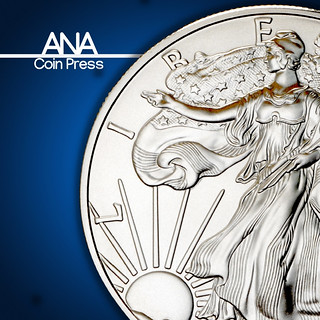 When it comes to legal tender, there are two, related paradoxes in numismatics.
When it comes to legal tender, there are two, related paradoxes in numismatics.
The first is that collecting a coin or banknote becomes possible only when it is removed from circulation, even though its legal tender status is a big part of what makes it collectible in the first place.
The second paradox is the inverse of the first: sometimes, collectible numismatic items are legal tender, but are not actually intended for circulation.
But, here as usual, paradoxes reveal interesting possibilities. And to understand those possibilities, it's important to understand the meaning of the term legal tender – a sometimes subtle concept. It turns out that when trying to understand what legal tender really means, the best approach is to focus on what it doesn't mean.
Legal tender status does not necessarily require acceptance. The Coinage Act of 1965 states that United States coins and currency (including Federal Reserve notes and circulating notes of Federal Reserve banks and national banks) are legal tender for all debts, public charges, taxes, and dues.
So, anyone who wants to make their mortgage payment with a sack of Sacagawea dollars, or pay their property taxes with a pallet of pennies, may – may – have some legal ground to stand on (along with some very significant practical difficulties). But ordinary exchanges involving goods and services – i.e., transactions where no debts are being repaid – are an altogether different story. In such situations merchants have the right to impose restrictions, for example, no bills larger than $20, or no pennies. Businesses may even be entirely cashless, though some localities do require businesses to accept cash (if not any particular form of cash).
Legal tender status is not just a technical issue. The constitutional basis for paper money was considered, sometimes contentiously, in a series of Supreme Court cases decided from 1870 to 1884. These cases, known collectively as the Legal Tender Cases, were a response to the emergency issue of United States Notes, not backed by gold, during the Civil War.
The Court initially held that the notes were unconstitutional, as they deprived creditors of property (i.e., gold) without due process. (Ironically, this argument was made by Chief Justice Salmon Chase, who had guided the notes' issue as Treasury Secretary.) But, after some membership changes, the Court ruled instead that the notes were justified as wartime emergency measure. Later, the Court decided that because the Constitution did not prohibit it, the federal government could issue paper money at any time.
To read the complete article, see:
CIRCULATING AND NON-CIRCULATING LEGAL TENDER
(https://blog.money.org/coin-collecting/circulating-and-non-circulating-legal-tender)
LOOSE CHANGE: MAY 30, 2021
Here are some additional items in the media this week that may be of interest. -Editor
An article by Ursula Kampmann on the Künker website discusses Sebastian Dadler's Medal Commemorating the Death of William II. -Editor
We do not know who commissioned the medalist Sebastian Dadler, who lived in Hamburg at the time, to create a medal that interpreted the death of William II as the fortunate intervention of a divine power. But we do know that there was a large Dutch community in Hamburg and that Hamburg had close trade ties with Amsterdam. Hamburg merchants, just like their Amsterdam counterparts, probably appreciated peace as the basis of their business and thus gladly acquired a medal that depicted their view on the matter.
In order to comment on the death of William II on a medal, Dadler drew on well-known myths from ancient times. Thus, the obverse alludes to the Trojan horse, which carried ruin to Ilion in its belly.
On the obverse we see a large horse in front of the city view of Amsterdam. The horse is decorated with a magnificent saddle blanket. It features a sealed treaty with the inscription UNIO (= union) and RELIGIO (= denomination / faith). The saddle blanket represents the official propaganda of William II. He invoked his office as Governor General of the United Provinces of the Netherlands and propagated Calvinism as the religion that had to be protected everywhere.
What Dadler and his clients thought of this is expressed by the word SIMULANT, which is Latin for they deceive, pretend
. This statement is illustrated by the soldiers hidden under the saddle blanket.
To read the complete article, see:
Politics, Religion and Divine Retribution: The Failed Ambitions of William II of Orange
(https://www.kuenker.de/en/information/presseinformationen/aktuelle-mitteilungen/363)
Geldscheine Online has an article (in German) about an interesting Germany-based banknote from Argentina - Banco Alemán Transátlantico. Cue Google Translate! -Editor
To read the complete article, see:
Die 200-Pesos-Banknote der Banco Alemán Transátlantico – Deutsche Uebersee-Bank von 1888
(https://www.geldscheine-online.com/post/die-200-peso-banknote-der-banco-alem%C3%A1n-trans%C3%A1tlantico-deutsche-uebersee-bank-von-1888)

